Disclaimer: This post contains affiliate links to handpicked partners, including tours, gear and booking sites. If you click through or buy something via one of them, I may receive a small commission. This is at no extra cost to you and allows this site to keep running.
Getting lost in temple corridors, descending into tombs, and witnessing the crossing of historical and religious timelines in structures and scripture carvings, deciding where to go and the best places to visit in Egypt can be quite a list to narrow down.
But on a route that uses Cairo, Alexandria, Luxor and Aswan as the main bases, you can cover a lot of ground, combining city visits and day trips to sites in deserts and on coastlines by cruising on the Nile.
You will want to see as many as possible since every site is unique. From Ancient Egyptian sites to ones with a multi-layered history over the ages, you will never stop marvelling at how people built these colossal structures. Or how such carvings and paintings have survived to the point that they look like people added them just a few years ago. You will stare endlessly at the murals as you try to piece together the historical timeline they are telling you.
Ready to get planning on where to go in Egypt? This guide to Egypt’s best sites has you covered.
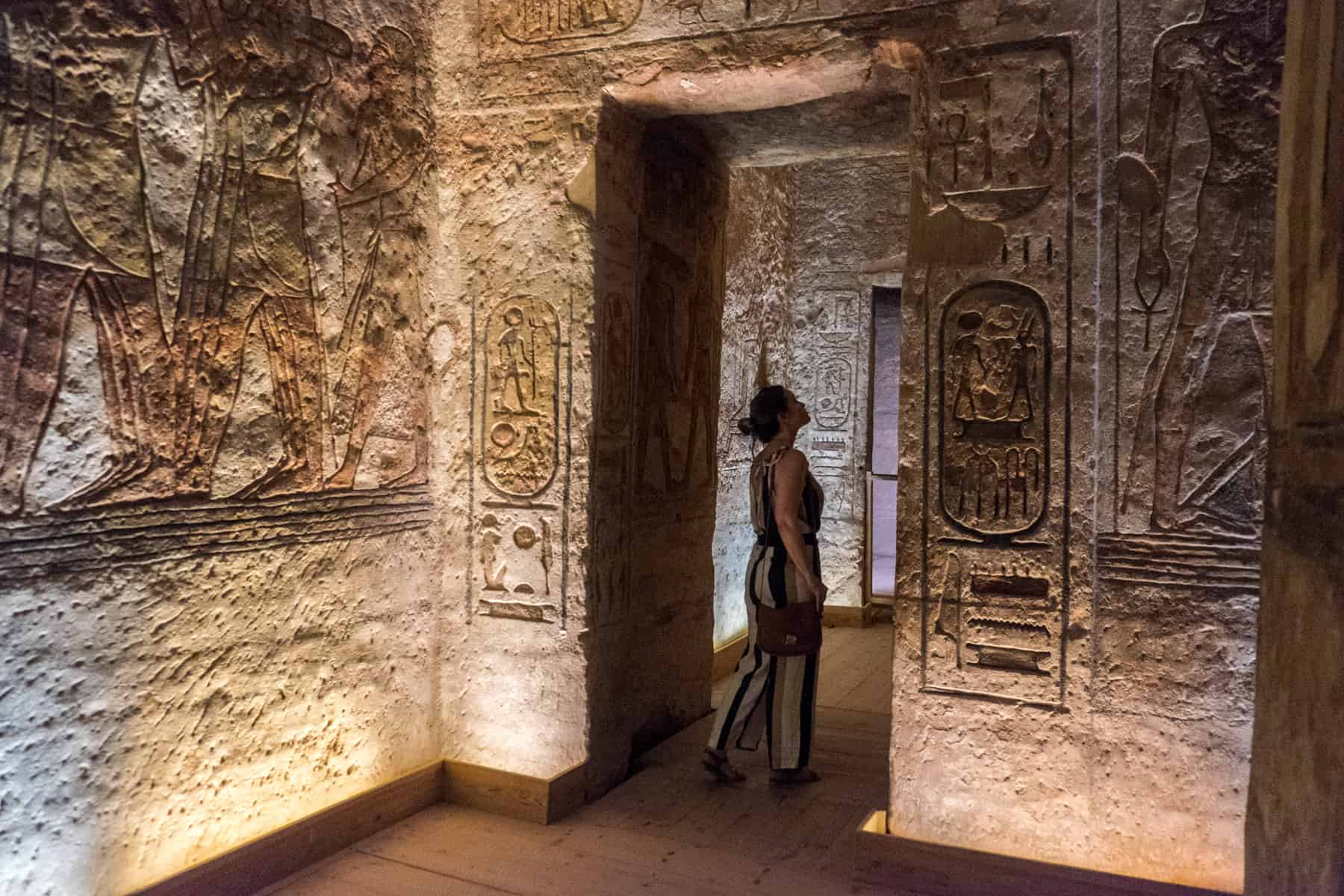
An Explorer’s Guide to the Best Places to Visit in Egypt
Contents
What Are the Best Places to Visit in Egypt?
It’s hard to put an exact number on exactly how many sites there are to visit in Egypt. Aside from the dozens already on show, many others are open but not easily reached or are currently undergoing excavation.
With new sites always being unearthed, even under peoples’ houses, Egypt will never be a one-visit destination. And who knows what different perspective you will have when you return to a site you once stood in before.
FULL TRAVEL GUIDE: Travel to Egypt Safely & Responsibly – Overturning Negative Perceptions
So, where to begin with all this archaeological excitement?
In a 12-day round trip from Cairo with G Adventures, I not only got to realise a childhood dream to visit Egypt (I had my heart set on being an Egyptologist), but I was able to see more sights in 10 full trip days on a small adventure group tour than I would have in trying to organise each area independently. Independent travel in Egypt is also possible but requires more time and on-the-ground hassle than it may be worth.
Here’s where to go in Egypt and what to see to explore the best of Ancient Egypt and beyond.
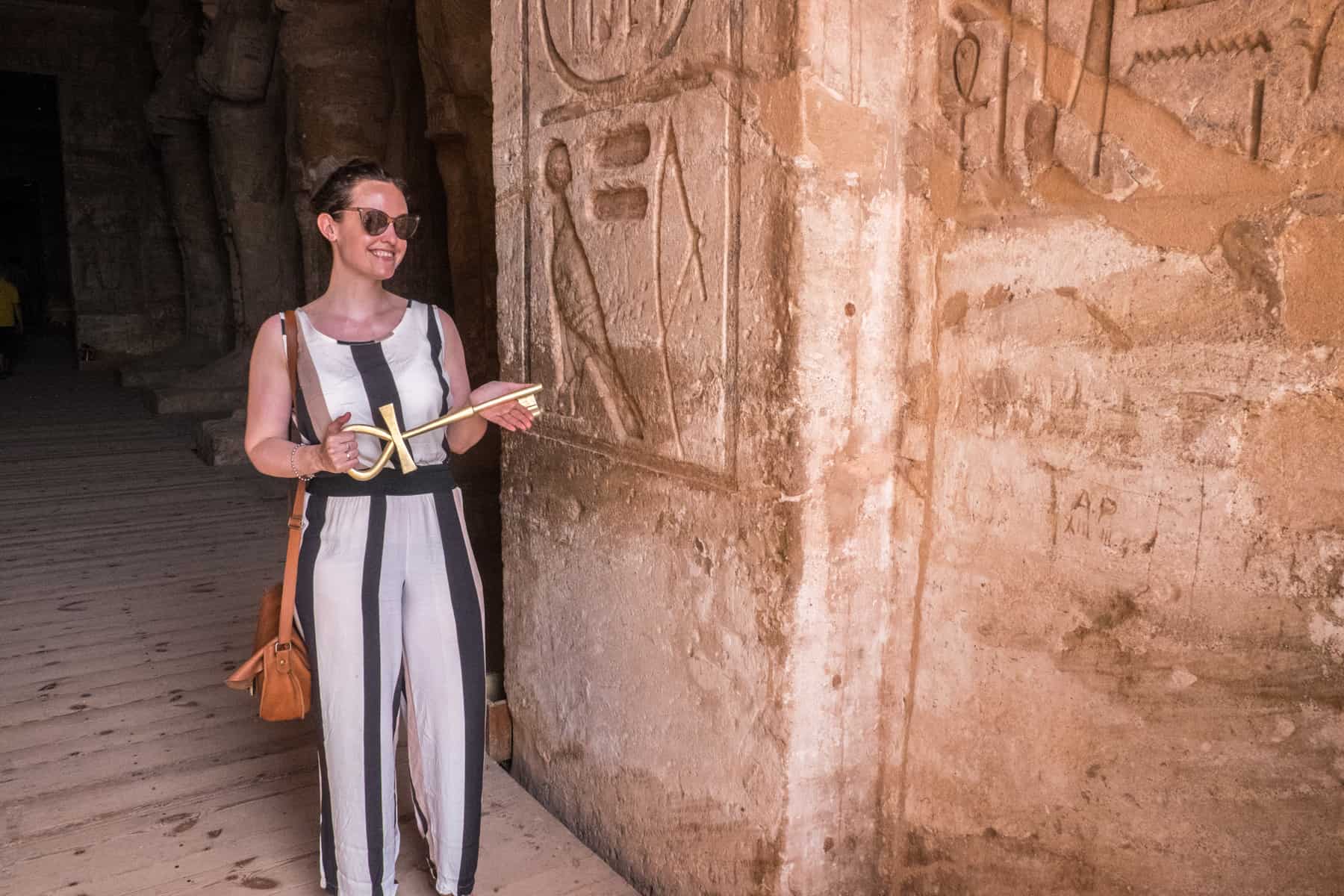
Planning where to go in Egypt? Start here.
Cairo – Home of the Last Remaining Wonder of the World
Cairo is where you come to tour the Great Pyramids of Giza and the Sphinx. It’s a rite of passage to traverse this highlight of Egypt in Giza’s once-remote desert area on the Nile River’s western side across from Cairo city in the East.
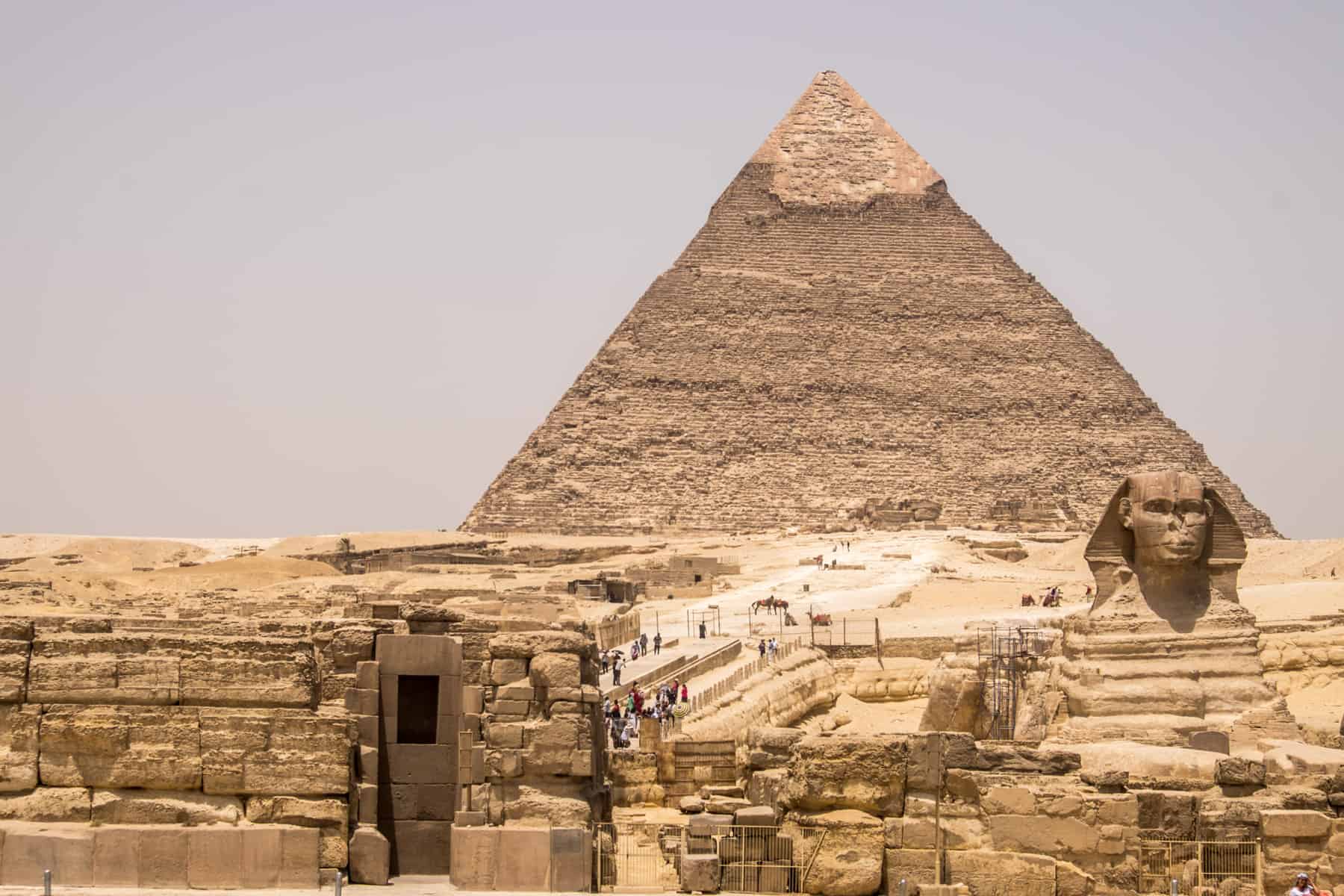
The Giza Pyramids and Sphinx site is one of the first you will visit in Egypt.
Giza Pyramids Necropolis
How does it feel to stand before the only one of the Seven Wonders of the Ancient World still in existence? Unimaginable. Nothing can describe the feeling of seeing the only remaining wonder of the world that you once marvelled at in history books and pictures.
Archaeologists estimate that Egyptians used up to 2.5 million stone blocks to build Giza’s Great Pyramid by hand. When you realise just how tiny you are compared to only ONE of those stones, you understand what a magnificent feat of architecture this was for the time.
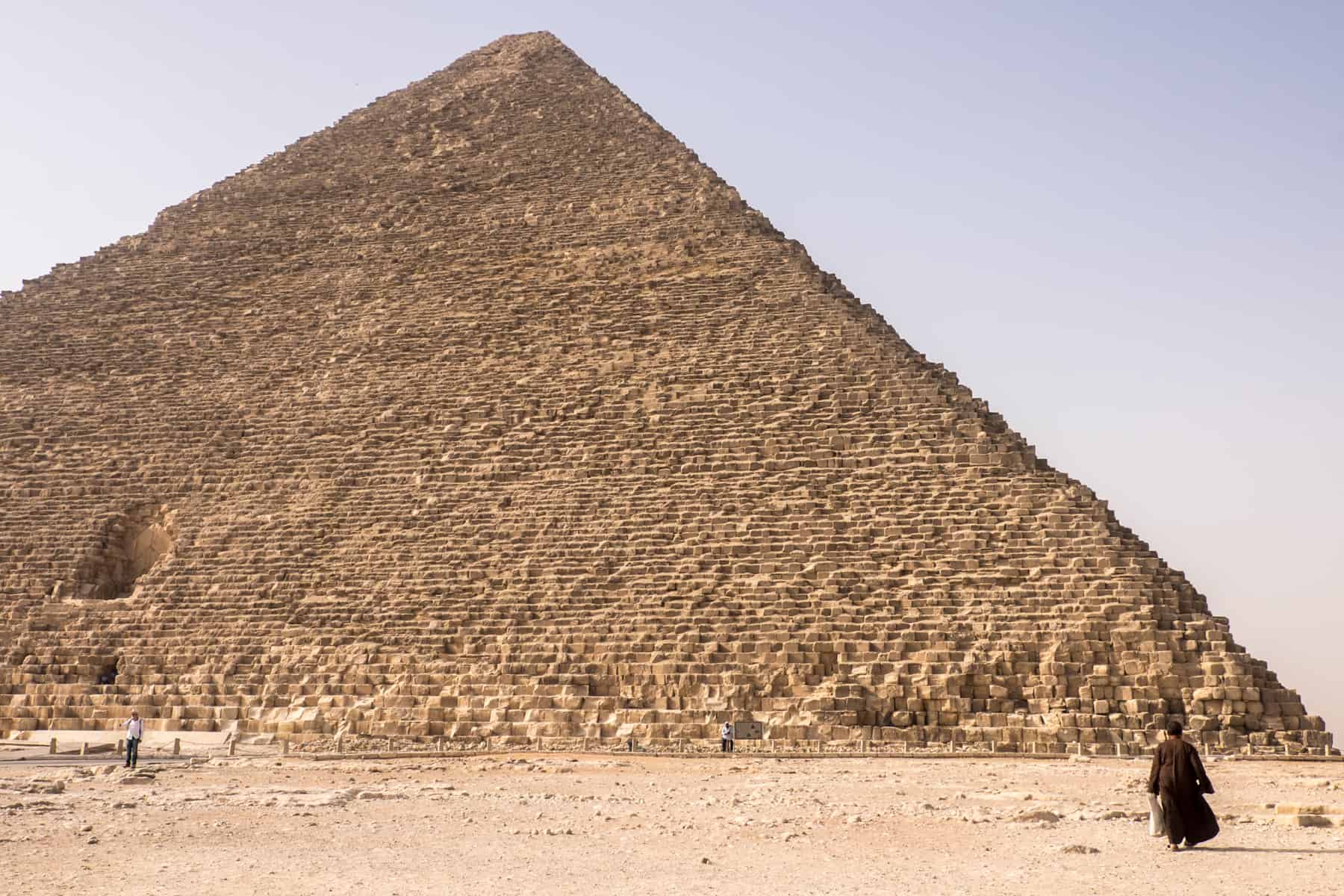
The Great Pyramid – the last remaining Ancient Wonder of the World – awaits.
Visiting the most iconic landmark of Egypt is a significant stop. It’s on everyone’s list, and one perk of the G Adventures Egypt tours is that you will be one of the first on-site to avoid the crowds. Coupled with an Egyptologist guide’s insights, you learn so much more about the historical structures when they are looming in front of you.
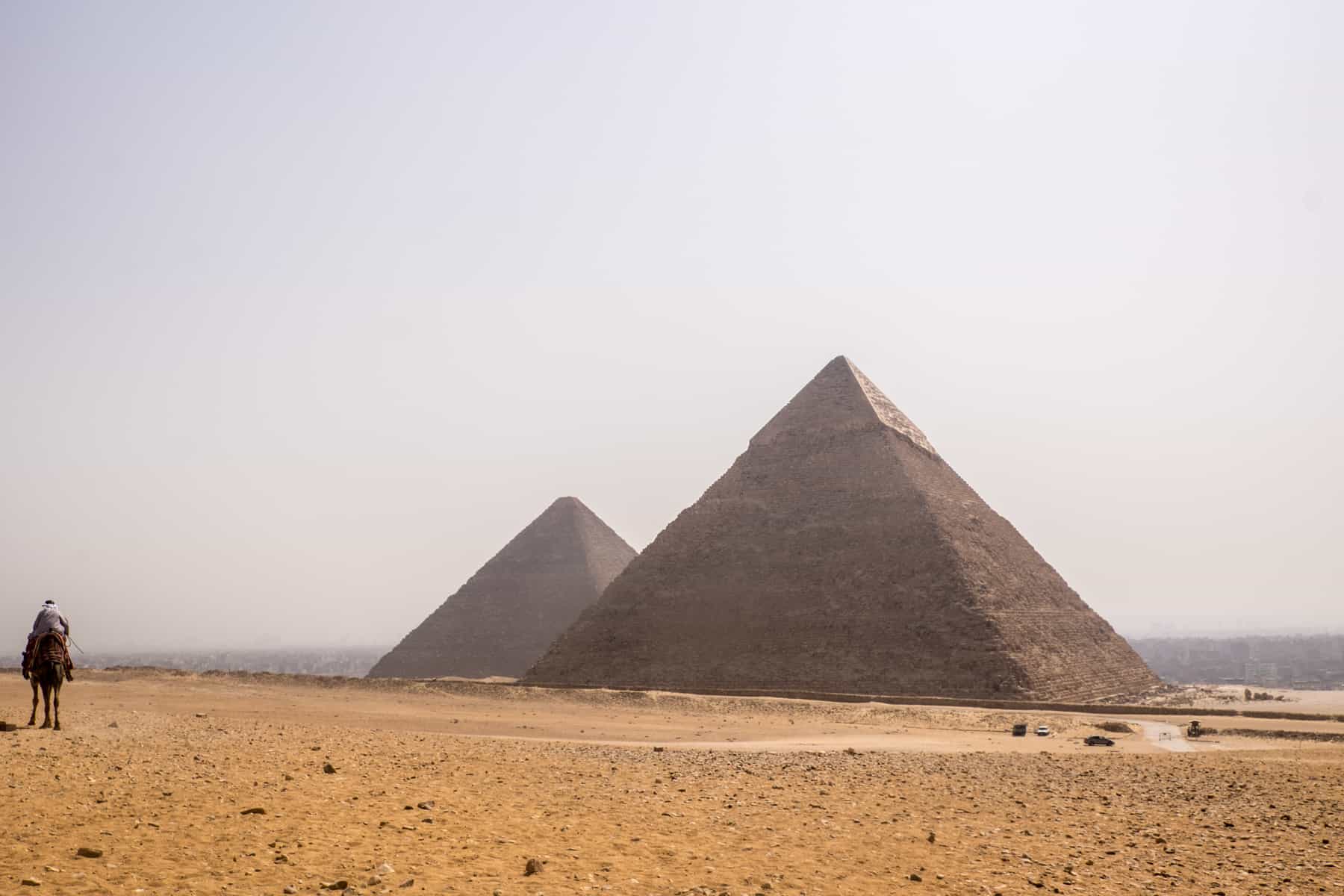
Visit the Giza Necropolis site.
Giza Pyramids Ticket Price
- Giza Pyramids: 160 EGP
- Entry to inside the Great Pyramid: 360 EGP
- Entry to inside the 2nd or the 3rd Pyramid: 100 EGP
- Entry to the Solar Boat Museum: 100 EGP
Giza Necropolis Opening Hours
- 06:00 – 22:00
Giza Pyramids Tours
- Tour the Pyramids and Sphinx, then take a Felucca ride on the Nile on this five-hour trip.
- Short on time? This half-day Pyramids of Giza and the Sphinx tour gets you straight to it.
- Whizz around the Pyramids on a quad bike, taking in the views of the desert city.
- Opt for a female-guided tour of Cairo covering the city’s highlights, including Giza, the Egyptian Museum, and browsing the Khan El Khalili Bazaar.
- Capture memories and tour the Pyramids with a photographer.
Egyptian Museum and Mummy Room
The Egyptian Museum contains over 120,000 artifacts documenting every period of Egyptian history. The main highlight is seeing all the treasures from the tomb of Tutankhamun and the Egyptian Mummy Room, where you can gaze upon some of Egypt’s greatest rulers, like Ramesses II.
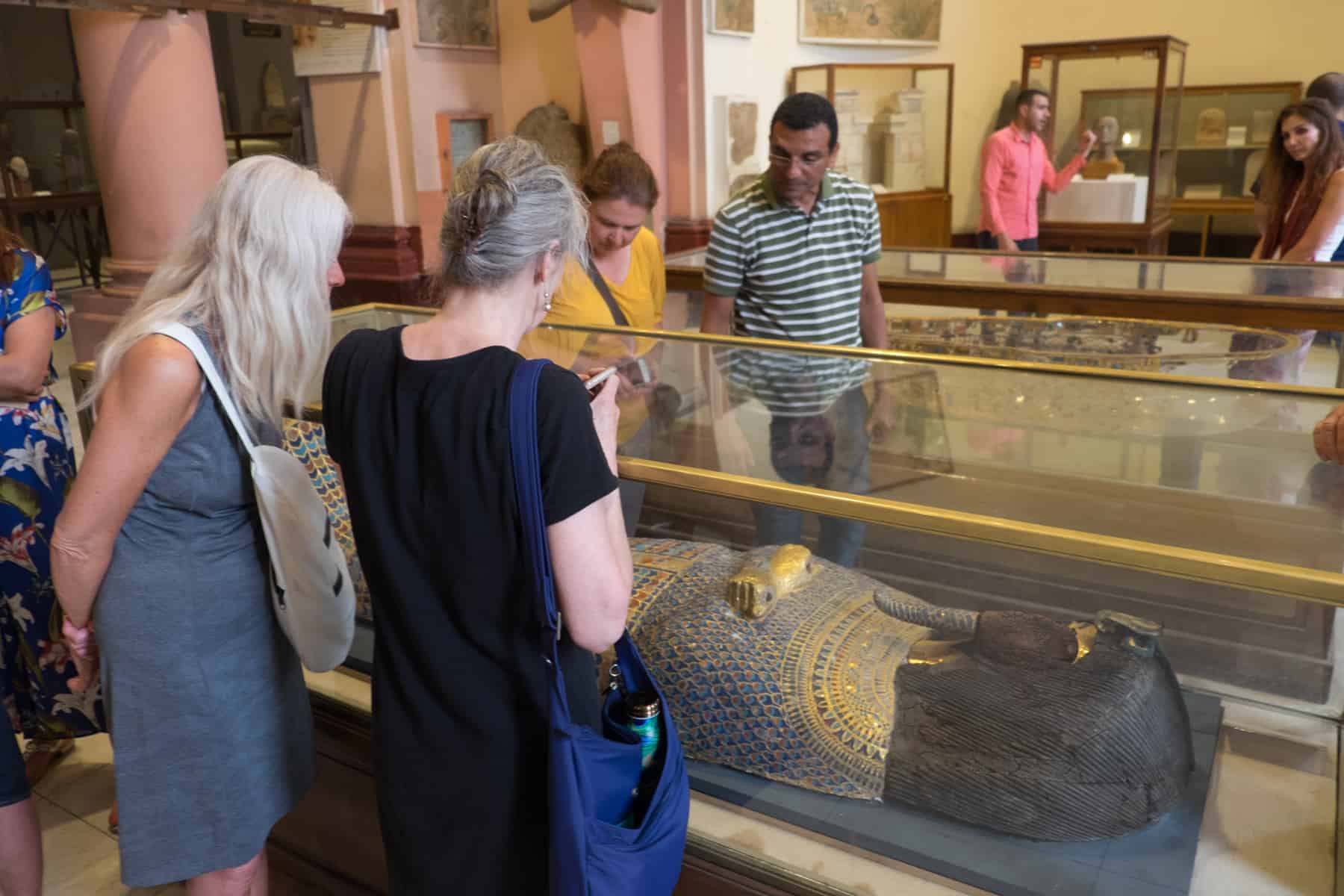
Gazing at one of the many thousands of artefacts in The Egyptian Museum.
Our G CEO, Said, was present to facilitate our trip and get us from A to B with ease and a local with expert knowledge and qualifications in Egyptian history and archaeology. Egyptians are proud of their history, and people like Said impart the facts and stories with great passion.
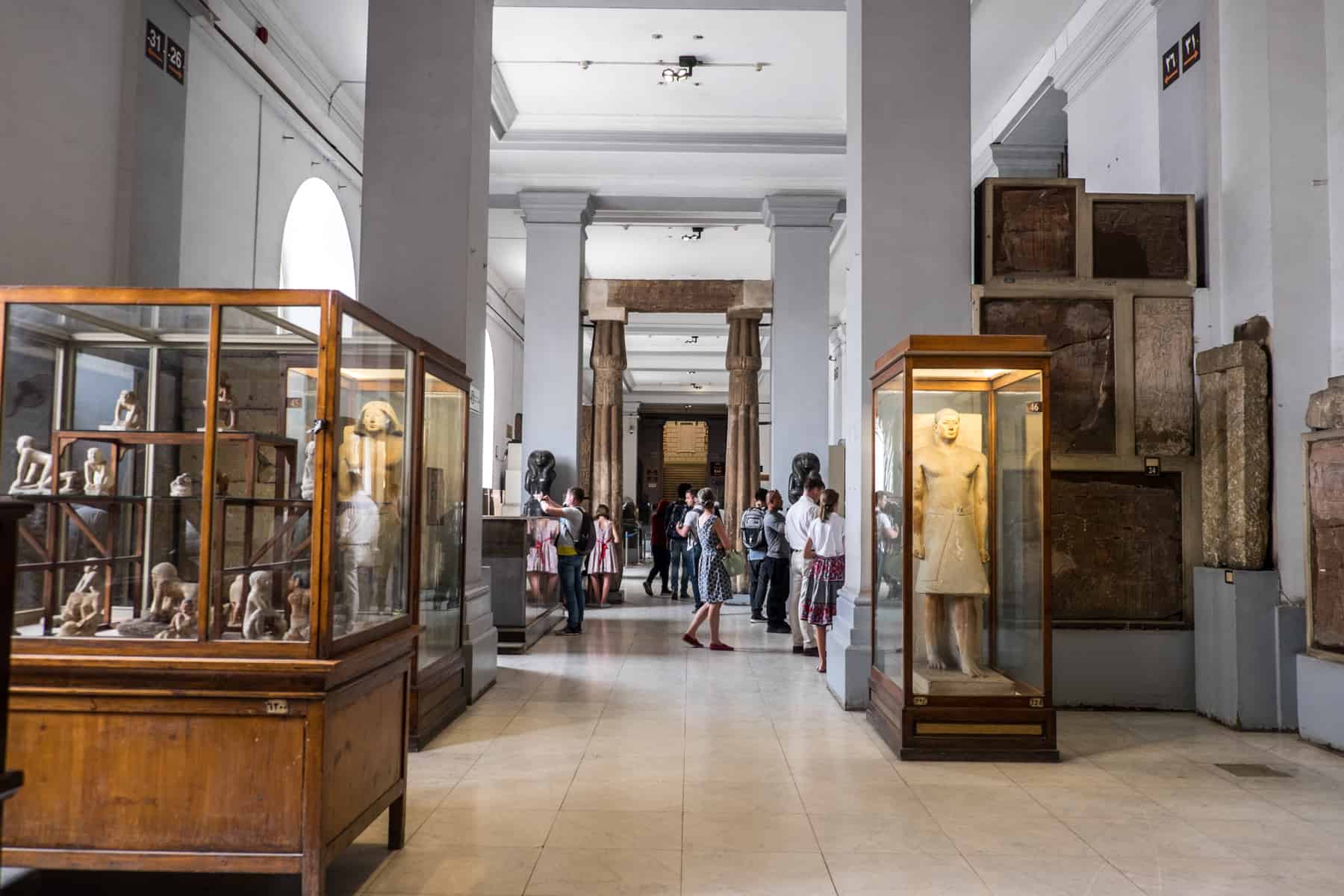
The fascinating. history-filled corridors of The Egyptian Museum are as much a highlight on your trip to Egypt as the temples and tombs themselves.
- Opening hours: 09:00 – 19:00, on Fridays 09:00- 11:00 and 1:30- 19:00
- Egyptian Museum Ticket Price: 60 EGP (regular); 30 EGP (student)
- Mummies Room entrance price: 100 EGP (regular); 60 EGP (student)
- Photography ticket cost: 50 EGP
Egyptian Museum Tour
- Take a half-day private guided tour of the Egyptian museum, including hotel pickup and transfer.
Khan el-Khalili Bazaar Visit
The bustling Khan El Khalili Bazaar stalls, mainly catering to tourists, didn’t overwhelm me. Still, as Cairo’s main bazaar, it is good to wander around and see it as part of the city’s overall makeup. For more local goods such as gold, silver, copper, perfumes, and antiques it is famous for, venture off into the narrow side streets where you can try your luck with some haggling.
Cairo Bazaar Tours
- Take an insider’s tour of four Cairo Bazaars and Souqs, including Khan El Khalili. Get off track, learn to haggle, and see the markets from a local perspective.
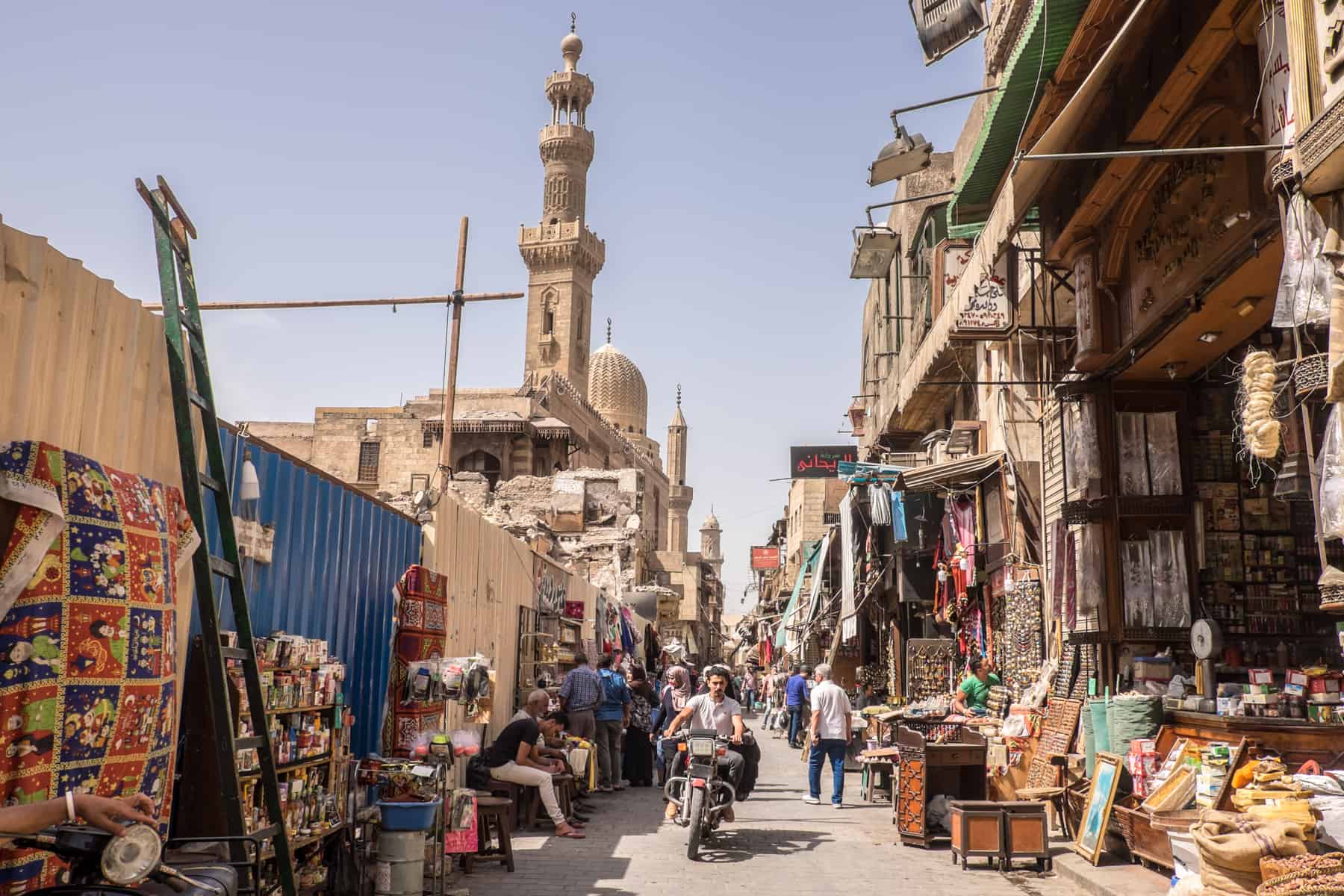
The bustling, dusty, chaotic, haggling-filled lanes of the Khan El Khalili Bazaar in Cairo.
Islamic and Coptic Cairo Tour
Before I started my big Egypt tour, I made sure to arrive early to make the most of my time in Cairo and view the city aside from its Ancient Egyptian fame. Hearing that Cairo was chaotic and uninteresting, I wanted to take a Cairo walking tour with a female guide to try and understand a city that has a rich history but a negative reputation. There’s also a female-led Cairo highlights tour that includes the Giza Pyramids.
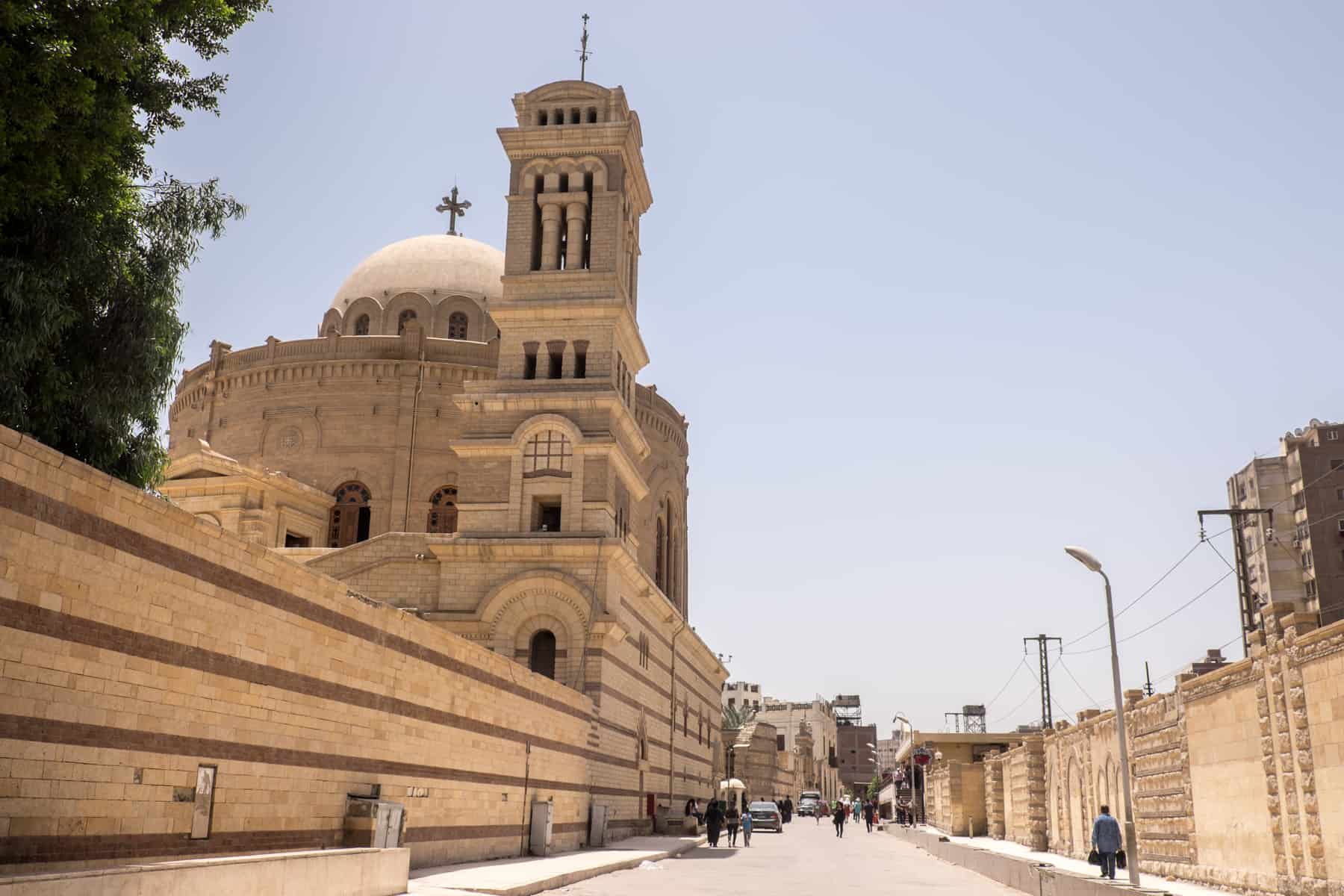
Take a walking tour in Cairo and see more of it aside from its Ancient Egyptian fame.
Cairo is a city where different faiths stand side by side and where history is layered in stone from the church foundations to the high reaches of Mosque minarets.
It’s a vast city, where the Coptic and Islamic sites are widely spread. So I enlisted the help of a female guide from a local walking tour company who was able to introduce me to the city in a half-day exploration. It included visits to the Hanging Church, Church of St.George, Saint Sergius and Bacchus Church (where the Holy Family came to rest after their journey into Egypt from Israel).
We then passed through Garbage City on the way to Saint Samaan, the Tanner Monastery built into the rock and ending in the Islamic part of Cairo.
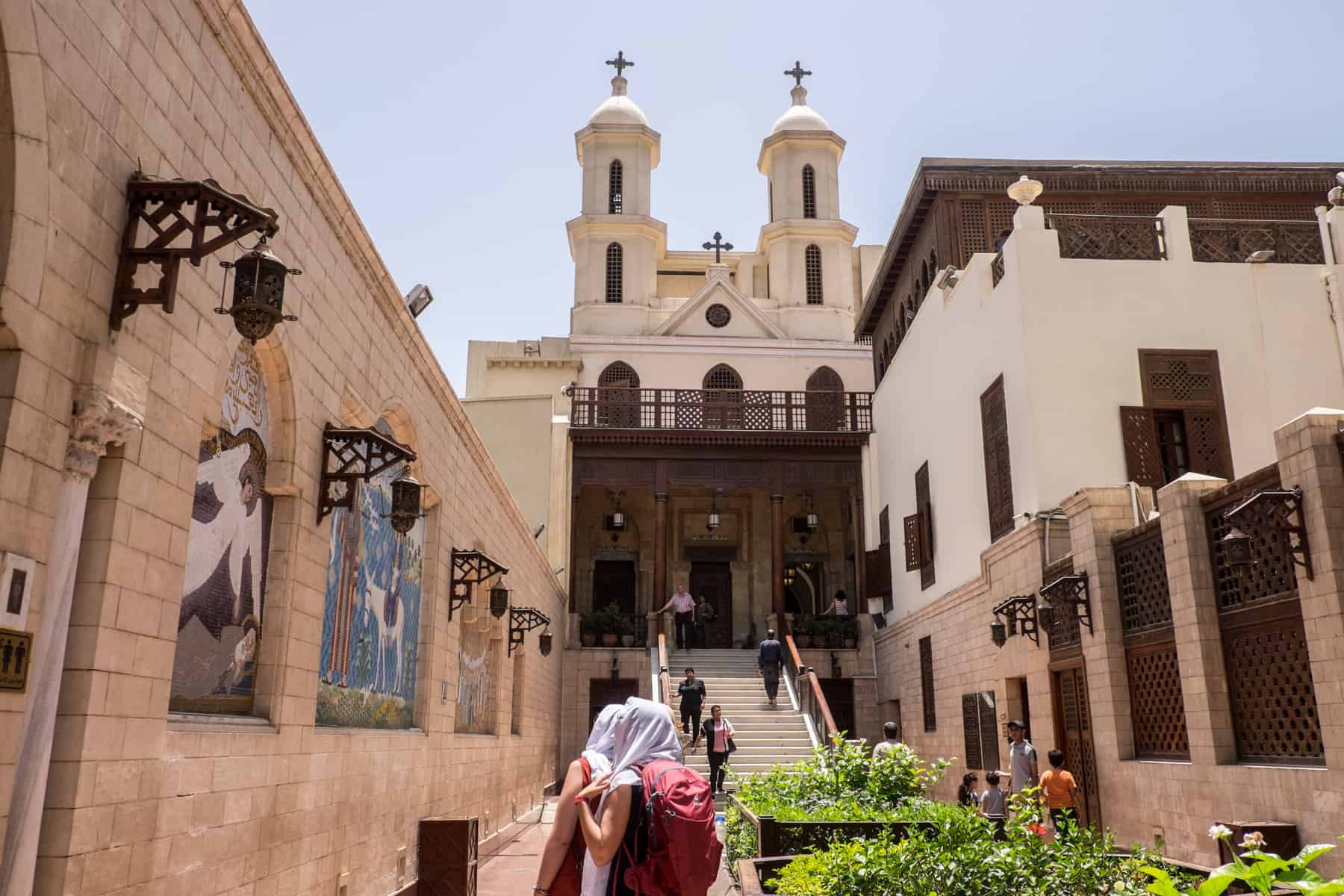
Entrance to Coptic Cairo’s Hanging Church.
One highlight was the Sultan Hassan Mosque – a remarkable great of architecture completed in the 1300s after three years of construction. It is one of the largest mosques in the world, whose walls stand nearly 40m tall and the minaret soars at 68m. You’ll often find yourself alone in its corridors filled with delicate carving and detailed paint patterns before emerging into brightly lit courtyards.
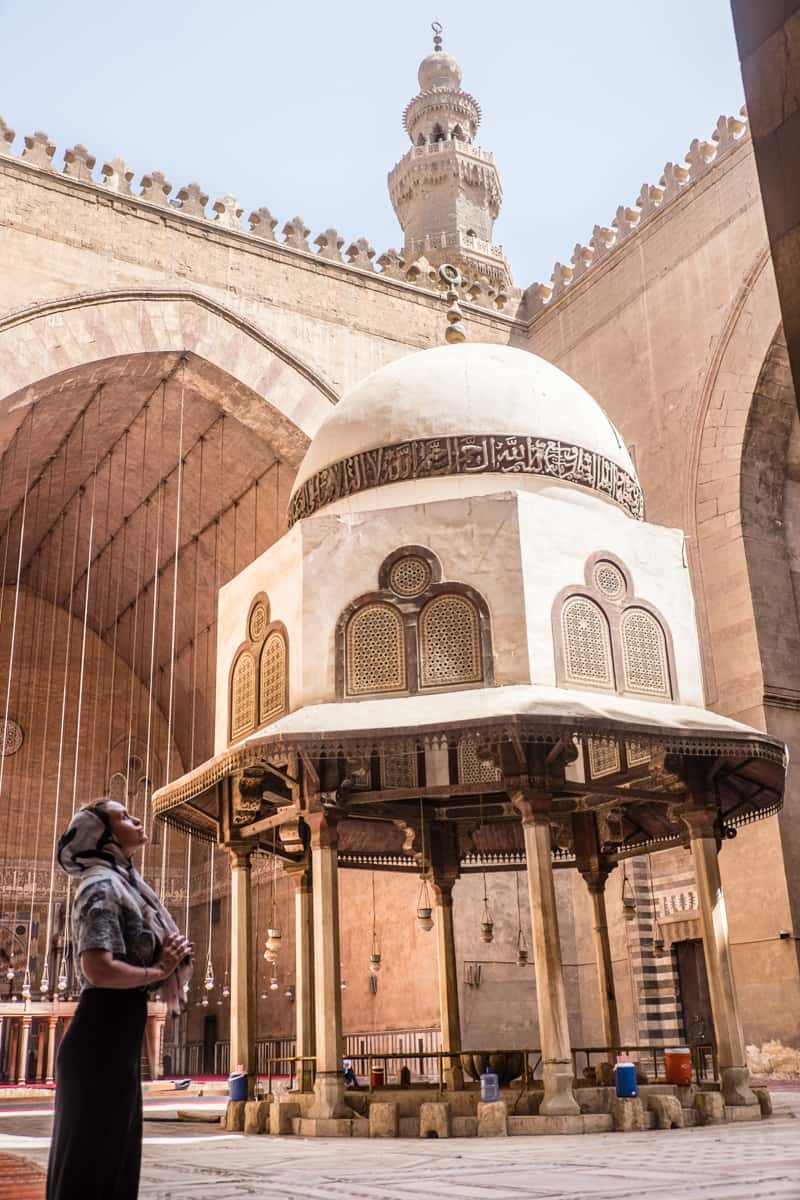
The intricate details of the Sultan Hassan Mosque, Cairo – one of the important religious sites to visit in Egypt.
- Sultan Hassan Mosque Ticket Price: 80 EGP
- Clothing: Modest clothing is required for religious sites.
Old Cairo Walking Tours
- Spend a full day visiting the sites of ancient Cairo, including the National Museum of Egyptian Civilization.
- Or opt for the Islamic and Coptic Cairo tour with a local lunch stop.
Saqqara and Memphis
On a day trip, we visited Memphis and Saqqara, around a 2.5-hour drive south of Giza.
Memphis is the ancient capital – where more artifacts have been found and put on display, like the massive statue of Rameses II, and where many more are still being uncovered.
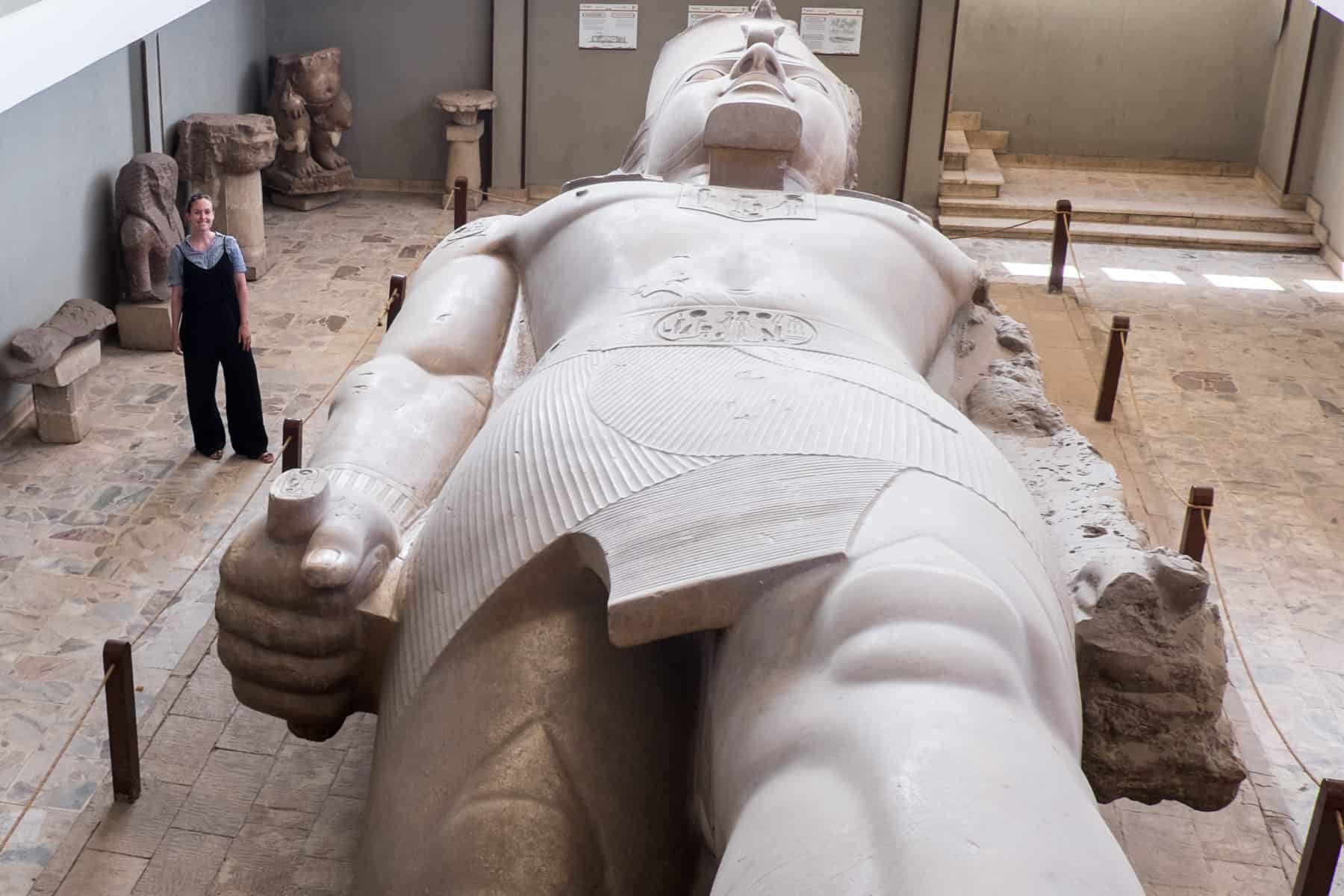
You are tiny next to the colossal statue of Rameses II at the Memphis site, Egypt.
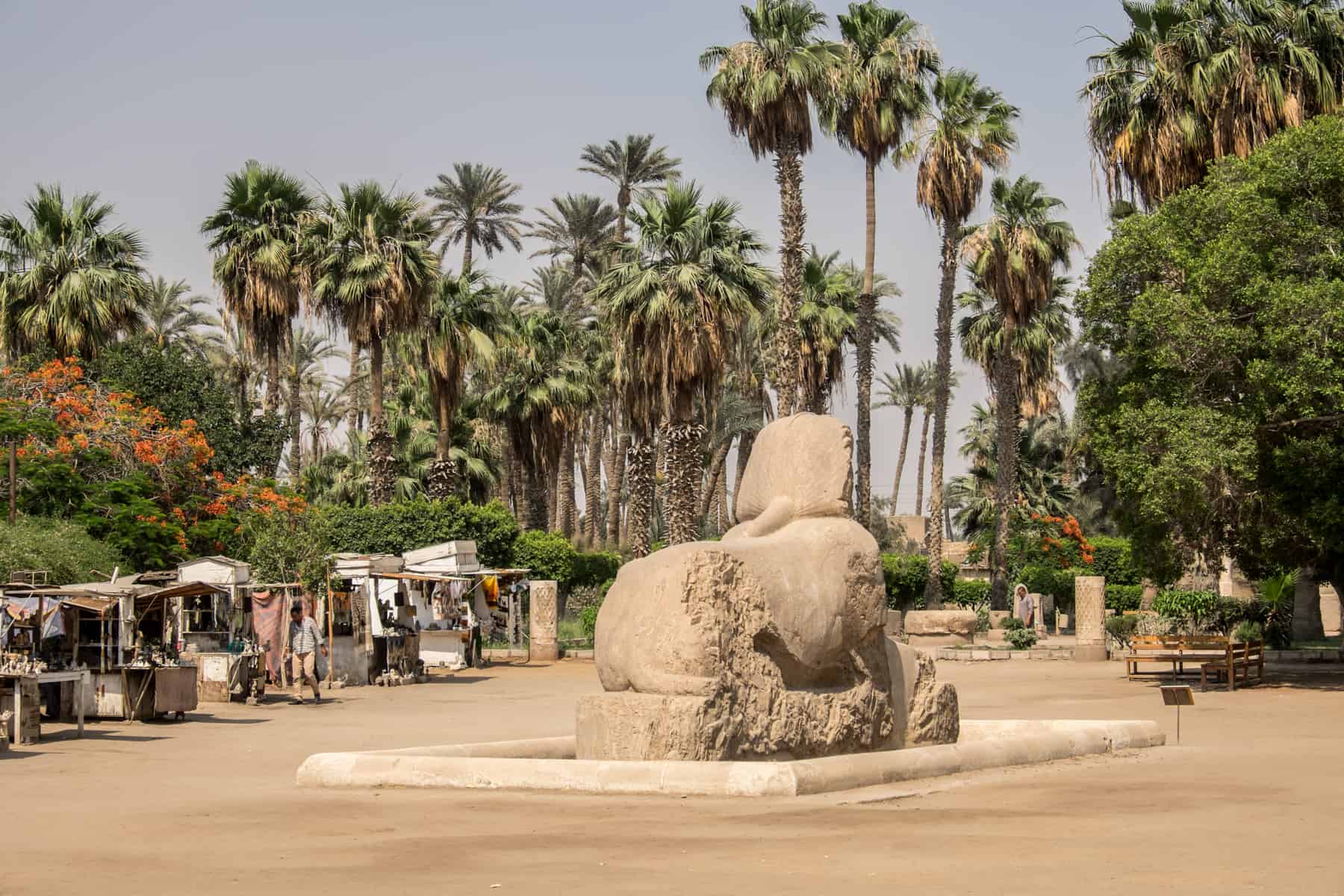
Market stalls and other artefacts line the museum’s outdoor space in Memphis, Egypt.
Saqqara is the site of Egypt’s first Pyramid, the famous Step Pyramid (The Pyramid of Djoser), and a vast archaeological site that is only starting to be extensively uncovered. Like the noble family tombs, which have only been open to the public for the last six months.
Who knows what will be here in two years as the work continues to find and understand the history of Ancient Egypt.
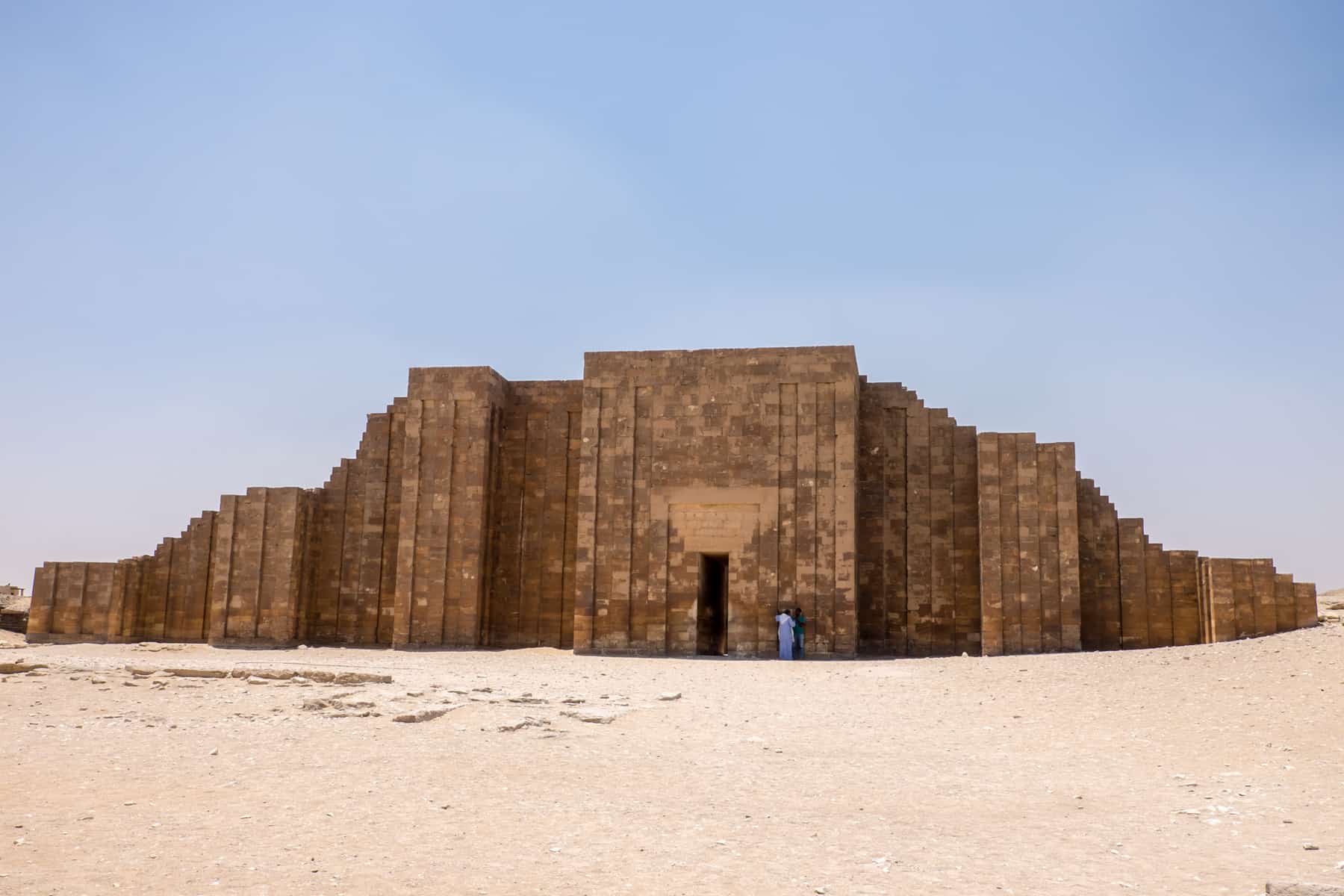
Visit Saqqara, the necropolis site of the Ancient Egyptian capital of Memphis.
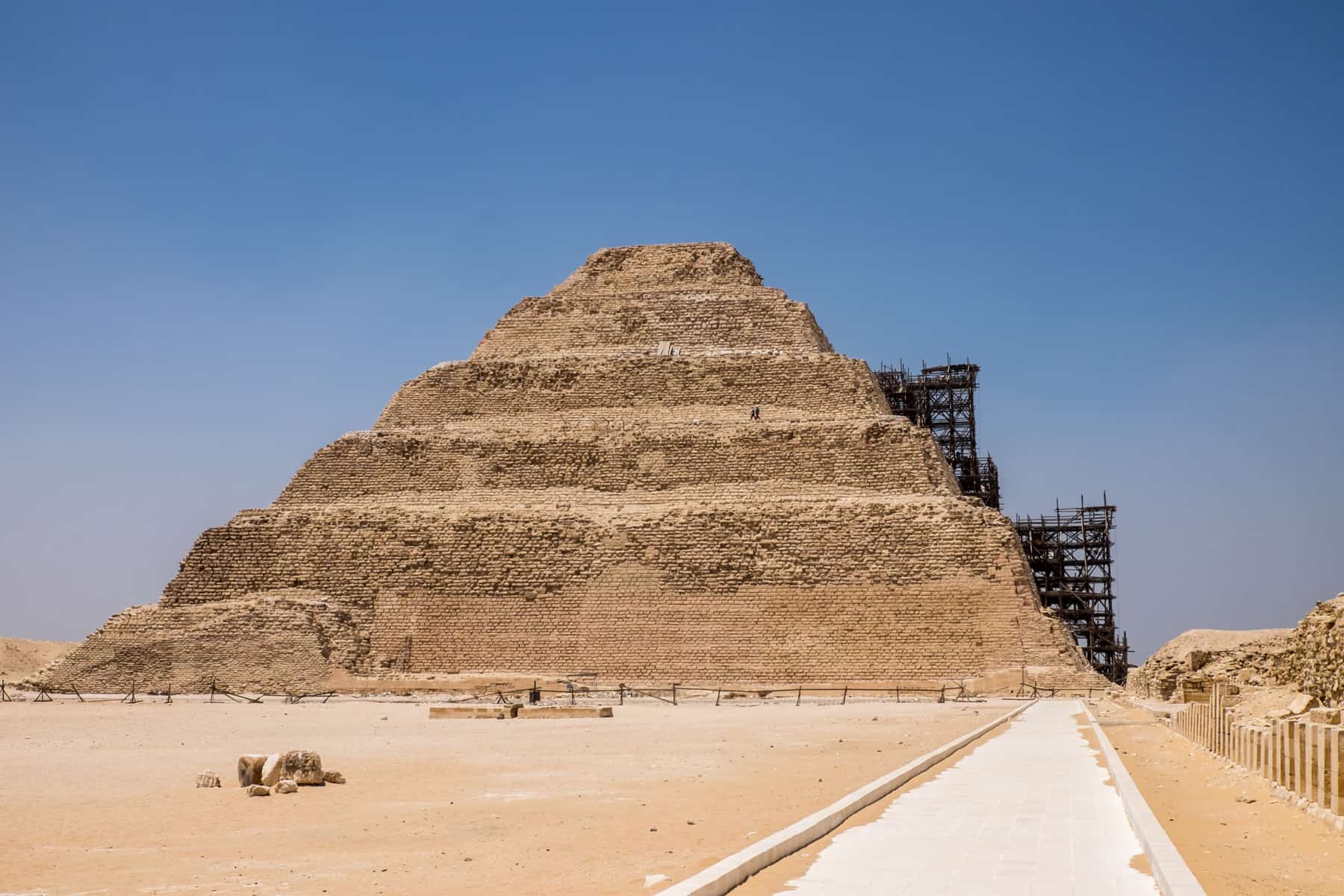
Marvel at Egypt’s first Pyramid, the six-tiered Step Pyramid of Djoser.
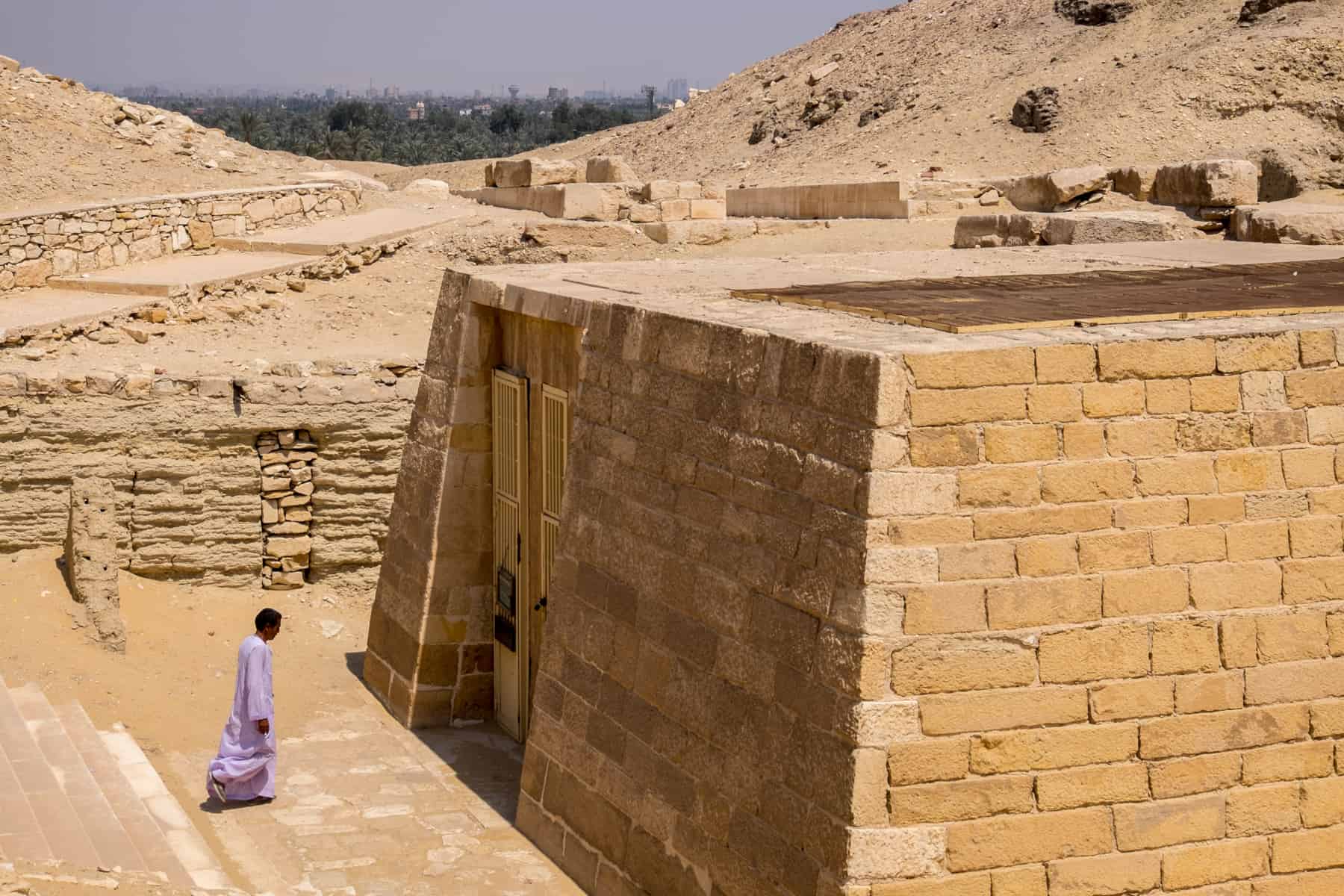
Saqqara is an ongoing archaeological site where you can visit recently excavated tombs.
- Opening hours: 09:00 – 17:00
- Saqqara Ticket Price: 150 EGP
- Saqqara New Tombs Ticket Price: 60 EGP
- Memphis Ticket Price: 80 EGP
Saqqara and Memphis Tours
- This trip was an extra to our Egypt tour and cost 650 EGP.
- If travelling independently, enjoy a full-day tour that combines Giza with Memphis and Sakkara.
Monasteries of Wadi Natrun
On the way to Alexandria, we stopped for a tour with a local monk at the Monasteries of Wadi Natrun. If the Coptic sights in Cairo are not enough, this is the chance to delve deeper into the history and importance of Wadi to Coptic Christians. Dating back to the 4th century AD, these Wadi sites are some of the earliest Christian monasteries in the world, standing in a relatively desolated desert land.
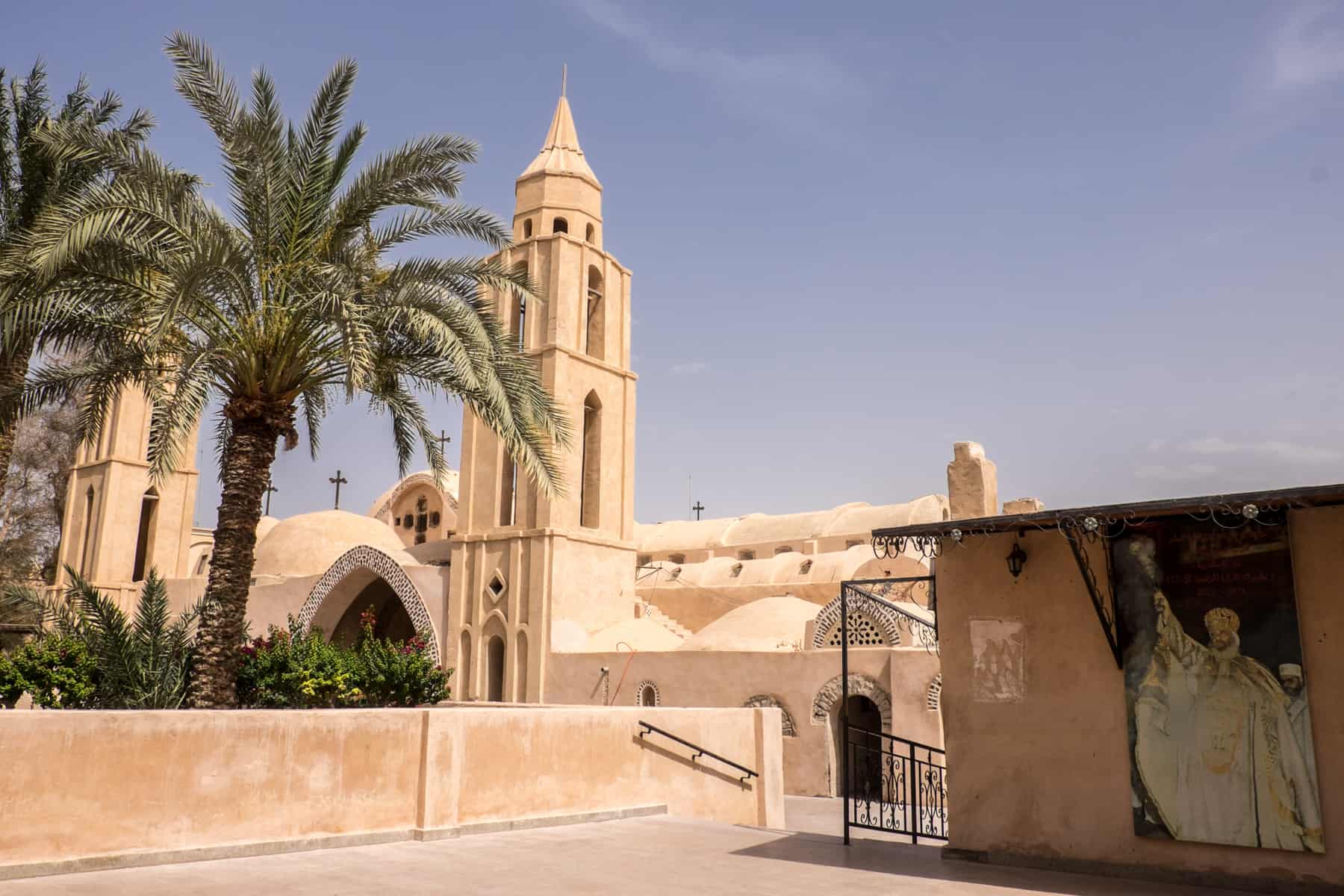
The grounds of the Monasteries of Wadi Natrun.
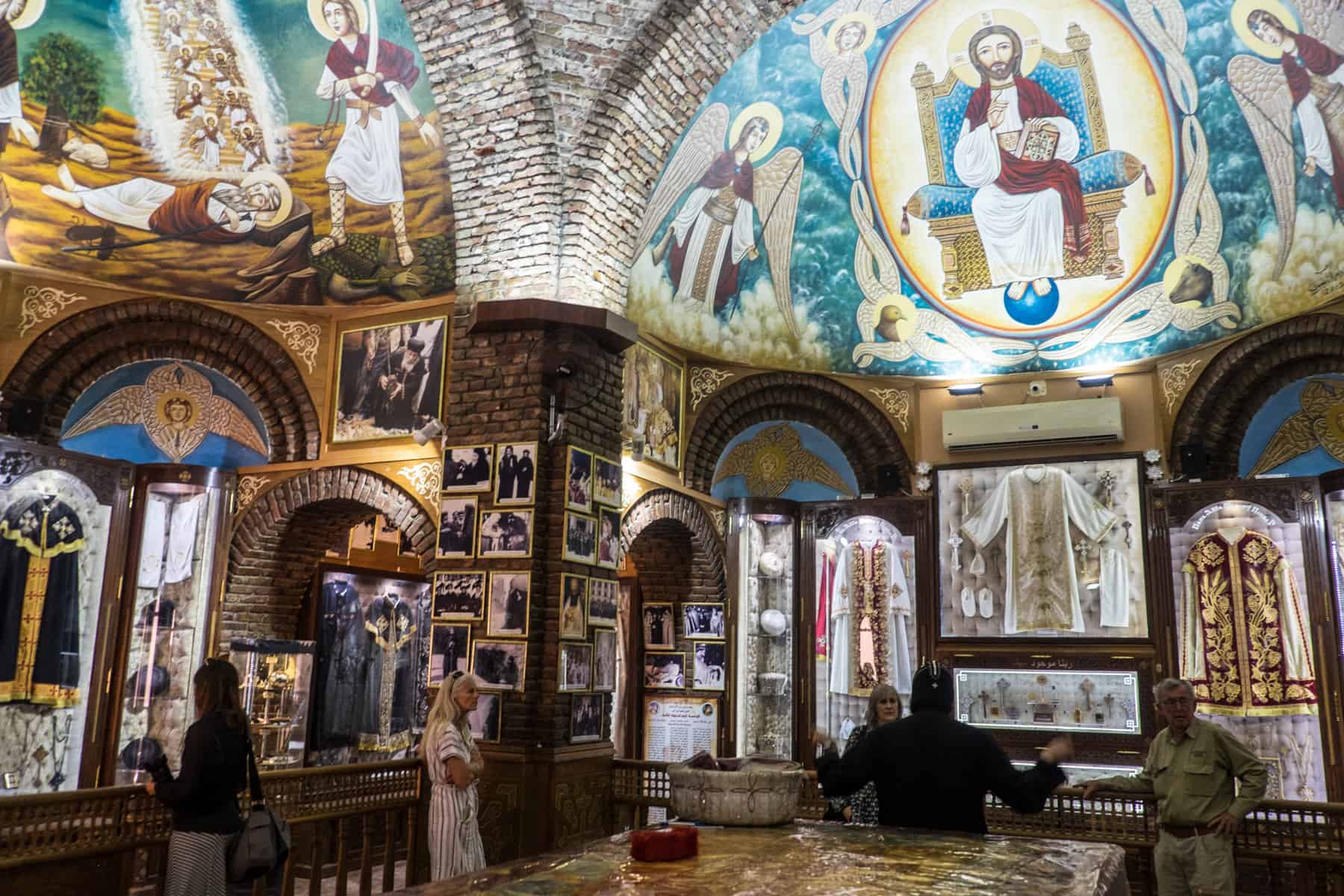
The colourful, detailed ceiling murals in the Wadi Natrun Monasteries.
Opening hours
09:00 – 17:00, on Fridays 09:00- 11:00, and 1:30- 19:00.
Monasteries of Wadi Natrun Ticket Price
60 EGP
How to get there
Accessible only by car or by bus. Hourly West Delta Buses leave Heliopolis station. Our tour included a visit to the monasteries.
Alexandria – European Character and Mystery
I always wanted to visit Alexandria, Anthony and Cleopatra’s home, whose tombs are yet to be discovered, and my trip included a loop there and back from Cairo. But it doesn’t make a visit to the northern city on the Mediterranean coast any less impressive.
Founded by Alexander the Great around 331BC, there are still many archaeological treasures to see and a chance to wind down in the streets tinged with a cooling seaside breeze.
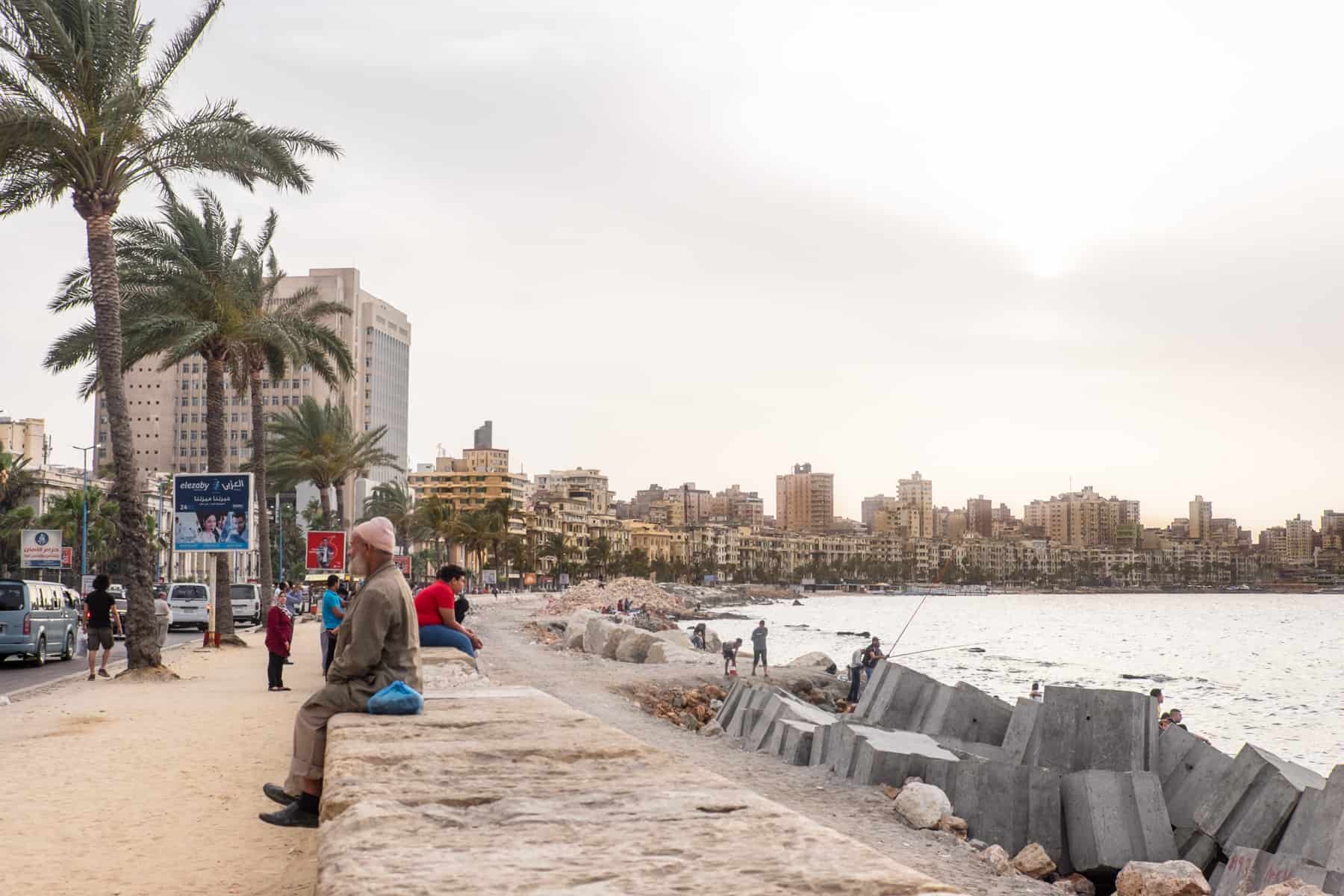
Wander Alexandria’s Mediterranean coastline.
Pompey’s Pillar
The site as it stands today might be small, hugged by modern apartment complexes, but Pompey’s Pillar stands proud. It is a Roman 20-metre-tall victory column from 297 AD that was once part of a large Roman temple complex. Erected in 293 for Emperor Diocletian, it is one of the largest monolithic columns ever created.
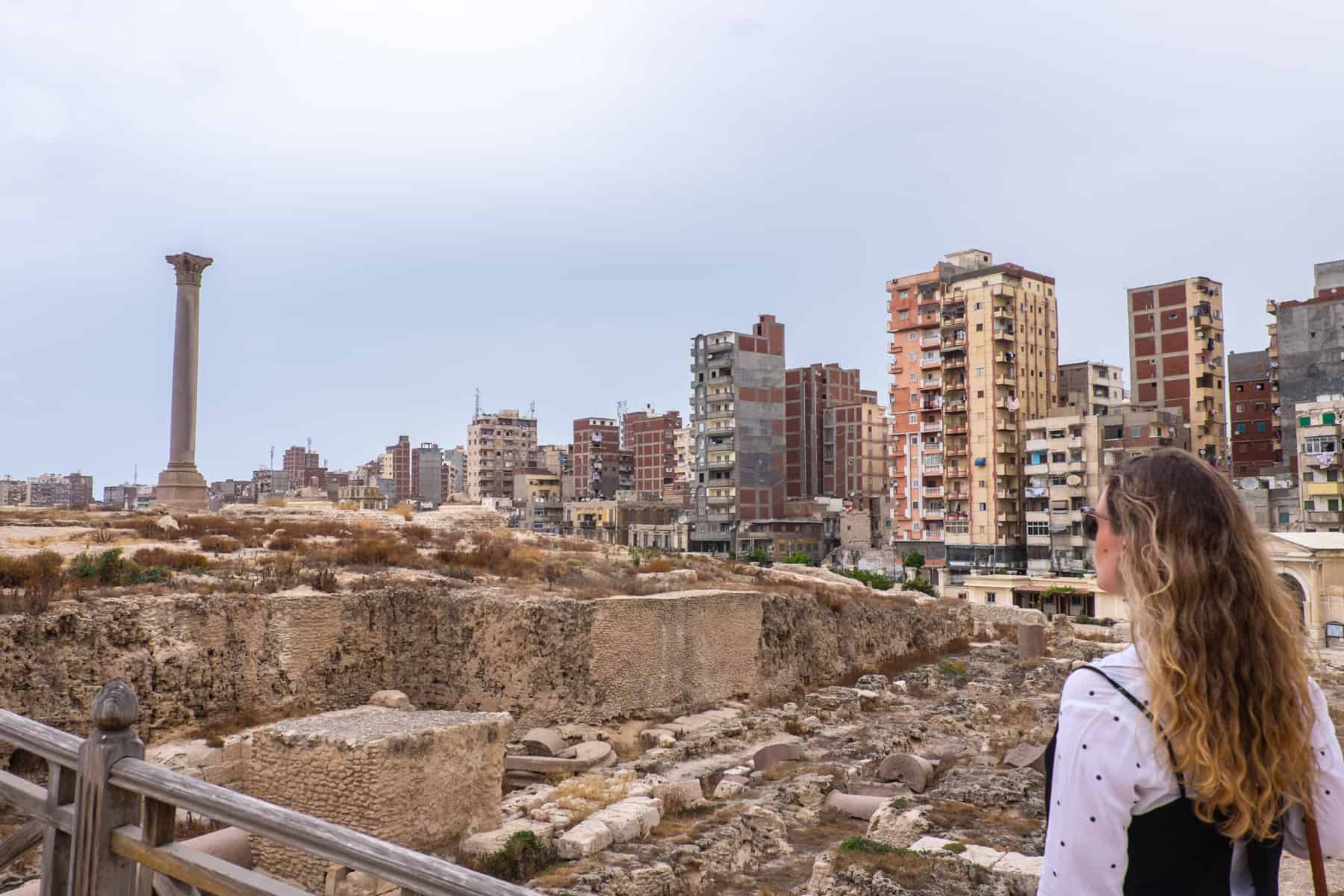
The site of Pompey’s Pillar in Alexandria, Egypt, surrounded by modern apartment buildings.
- Opening hours: 09:00 – 17:00
- Pompey’s Pillar Ticket Price: 60 EGP
Catacomb of Kom ash-Shuqqafa
A donkey fell down a shaft from the ground surface and uncovered these hidden tombs of Catacomb of Kom ash-Shuqqafa, carved into the bedrock deep below Alexandria. Accessible via a winding stairwell, the tombs were built in the 2nd Century AD in the age of the Antonine Emperors. It was the resting place for one wealthy family who was still practising Egypt’s ancient religion with a fusion of Greek and Roman religions, as suggested by the carvings.
- Opening hours: 08:00 – 16:00
- Catacomb of Kom ash-Shuqqafa Ticket Price: 80 EGP
Library of Alexandria
The Library of Alexandria was one of the greatest and most famous libraries of the ancient world. A master collection of knowledge that expanded during Greek rule. Destroyed by a fire in the 1st Century BC, what stands in Alexandria now is a new library that is just metres away from the ancient one’s perceived site. It stands with the same ethos – a centrepiece of scholarship and knowledge available to all.
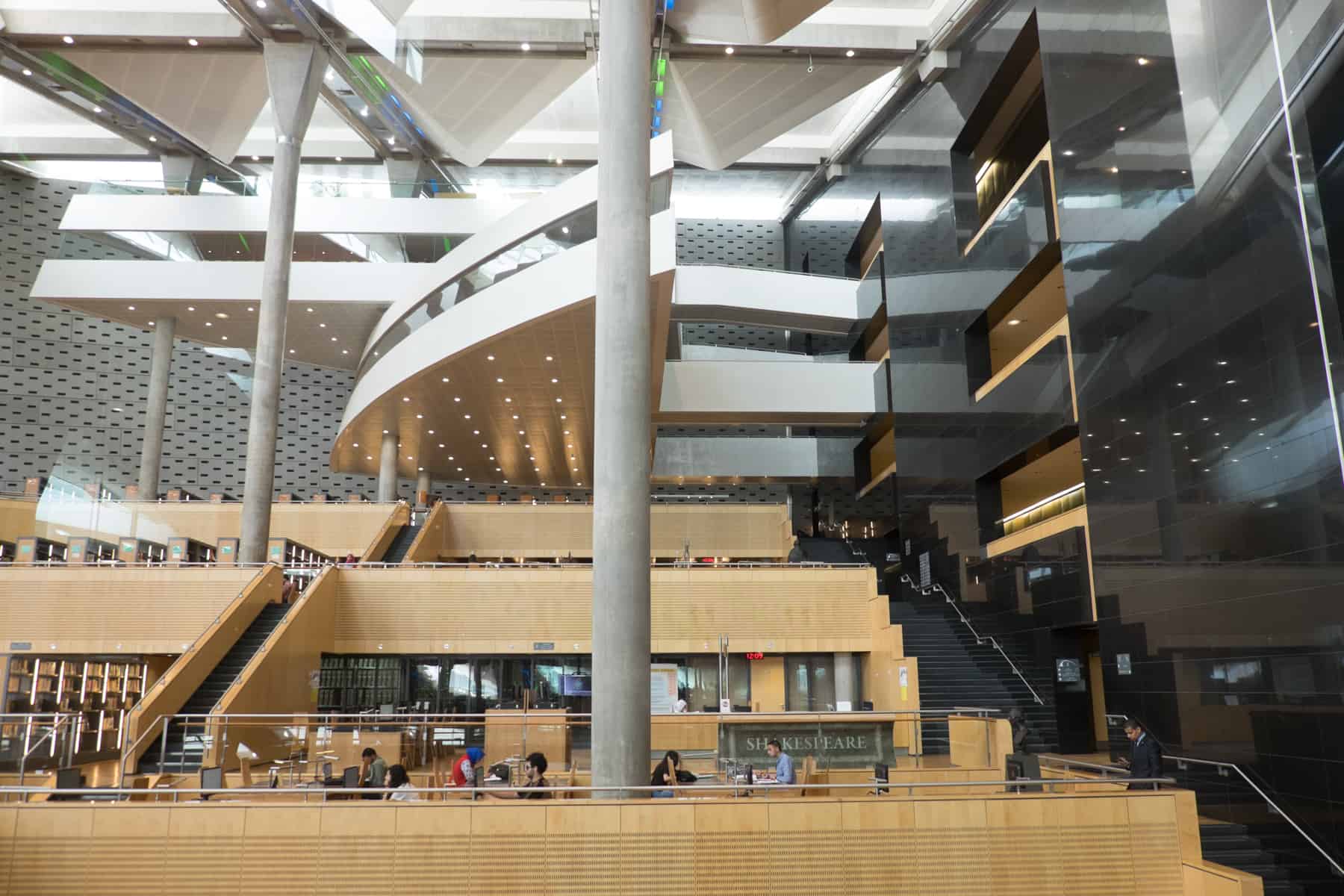
Inside Alexandria Library in Egypt, they are continuing the desire to collate a master collection of knowledge.
- Opening hours: 10:00 – 19:00 (Monday-Thursday and Sunday), 14:00 – 19:00 (Friday), 14:00 – 16:00 (Saturday),
- Library of Alexandria Ticket Price: 80 EGP
Tours of Alexandria
- On a round-trip from Cairo, enjoy an archeological-filled day trip to Alexandria, covering monuments, mosques, tombs, and royal gardens.
- If you are already in Alexandria, this full-day city tour is a great introduction to the historical landmarks.
Aswan – Nubian Egypt
From Cairo, we caught an early flight south to Aswan, giving up optimal time to explore the city on the banks of the Nile and the boardwalk Corniche. It also allowed time to get to the surrounding highlights without rushing as they are hours from the city.
Abu Simbel
A visit to Abu Simbel is a must-see and ended up being one of my favourite sites of all. The site is two rock temples carved out of the mountainside in Southern Egypt, built by the Egyptian Pharaoh Ramesses Il between 1274-1244 BC. One for himself and one for his wife, Queen Nefertari.
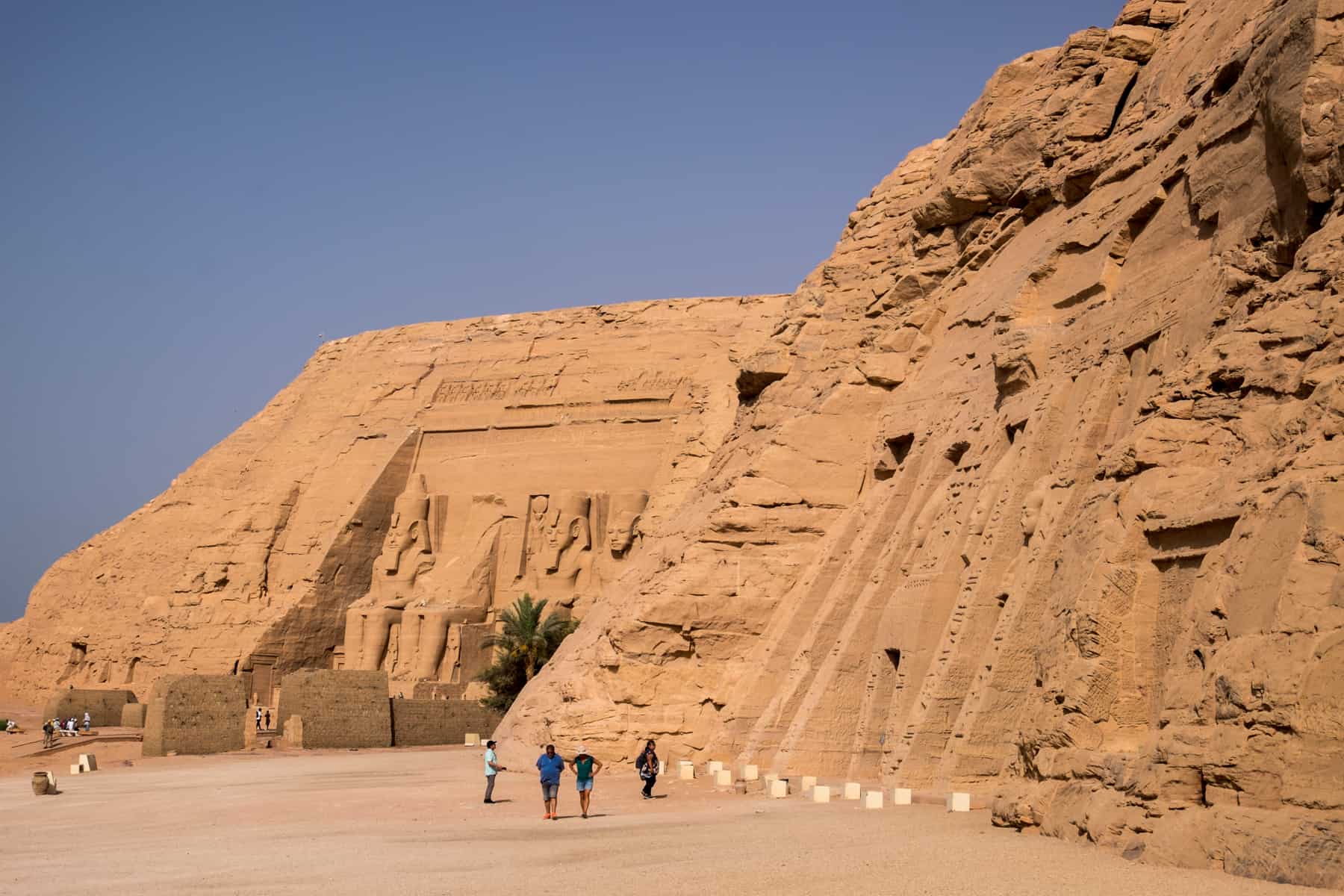
The mountain-carved temples of Abu Simbel are one of the best places to visit in Egypt and shouldn’t be missed.
Both temples symbolise love and pride, with colossal statues at the entrance over 20 metres high. Ramesses II dedicated the temple to himself in the godlike form alongside the sun gods Amun and Ra and Ptah of creation. Past the main entrance hall lined with colossal statues, each room continues to play out stories of battles and victories and scenes of offerings to the gods. Ramesses II had a reputation for being a great warrior.
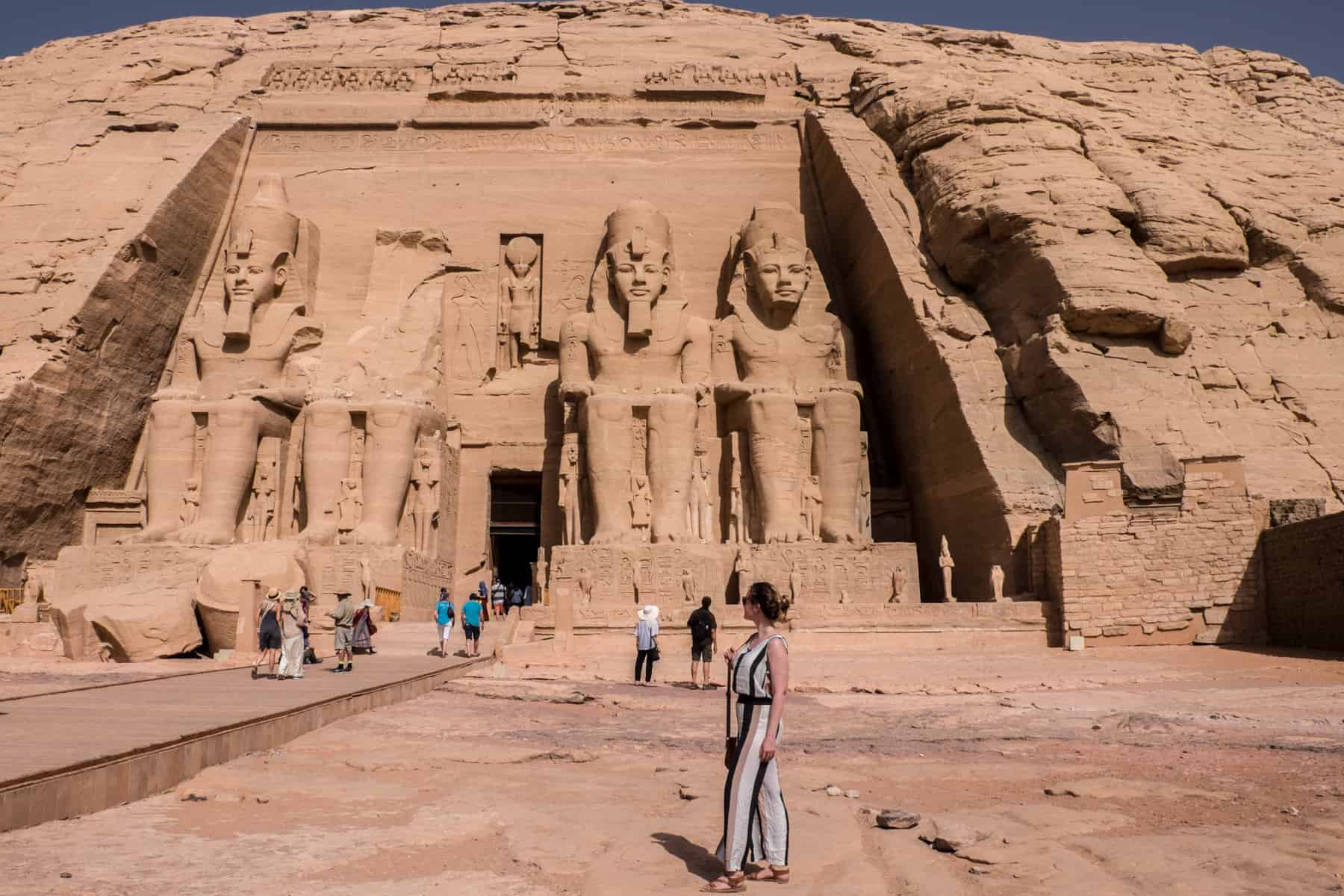
The temple of Abu Simbel dedicated to Ramesses II.

A tiny patch of the exquisite, intact detail inside Abu Simbel temple.
Considered one of Egypt’s most beautiful temples, it would be submerged today under Lake Nassar if it weren’t for modern engineering working to preserve history.
Both temples were dismantled and relocated in 1964 to a higher elevation to prevent being submerged by the Nile’s waters after the construction of the Aswan High Dam. To think this all could have been lost and be able to stand before it is a privilege.
It takes over three hours to drive from Aswan to the site, close to the Sudan border. It’s remote and worth the journey.
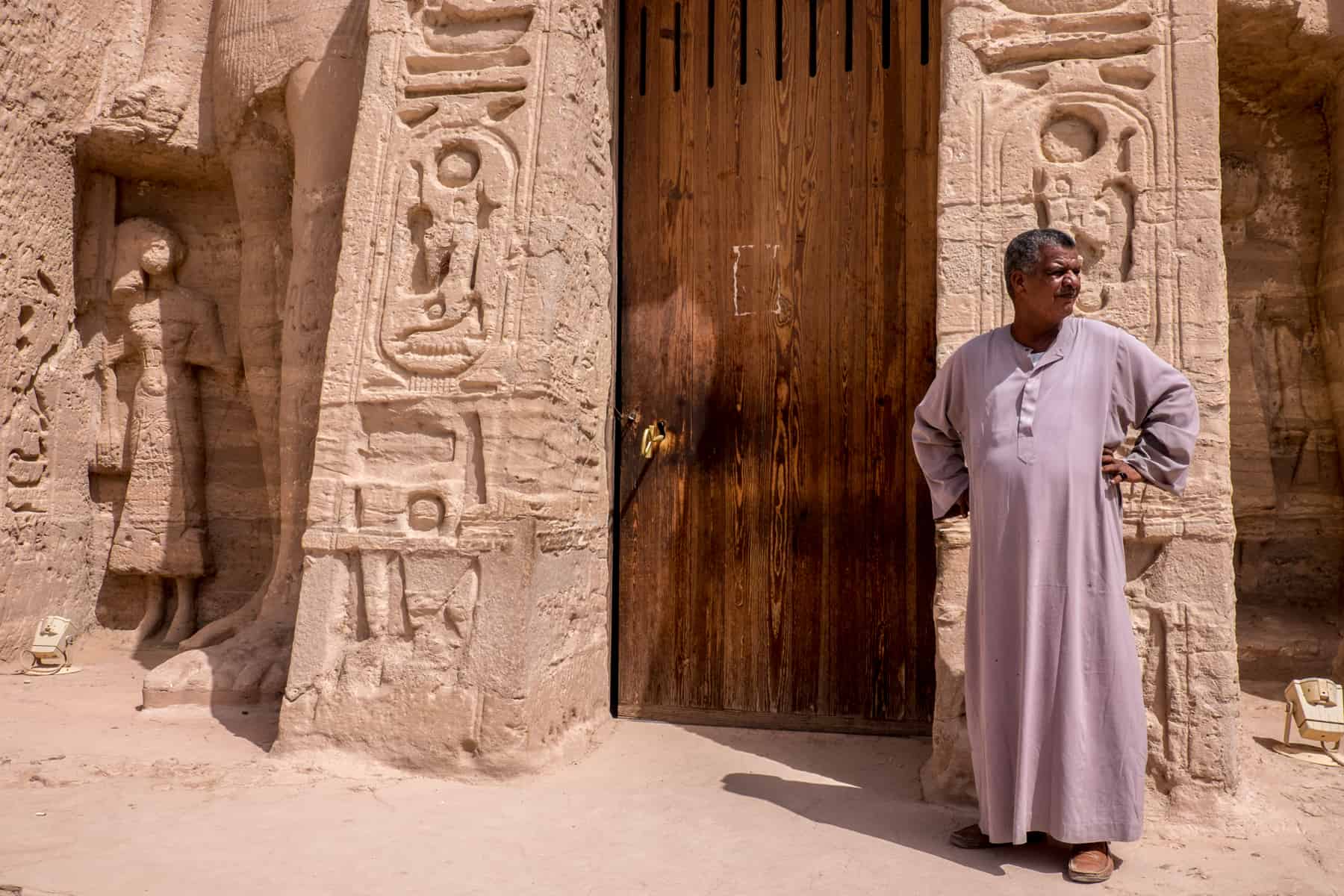
Guardians of the temple sites in Egypt.
- Opening hours: 08:00 – 16:00
- Abu Simbel Ticket Price: 200 EGP (includes entrance to the Documentation Centre)
Visit a Nubian Village
Boarding a felucca to take a trip along the Nile was more than just viewing Aswan city from the water or spotting the ruins of the Aga Khan Mausoleum on the hillside. It was also about supporting local initiatives that main tourism drives would otherwise overshadow.
Our transport was also a means to spend some time with local people from one of the Nile islands before visiting their Nubian village home for a walking tour and a delicious traditional dinner.
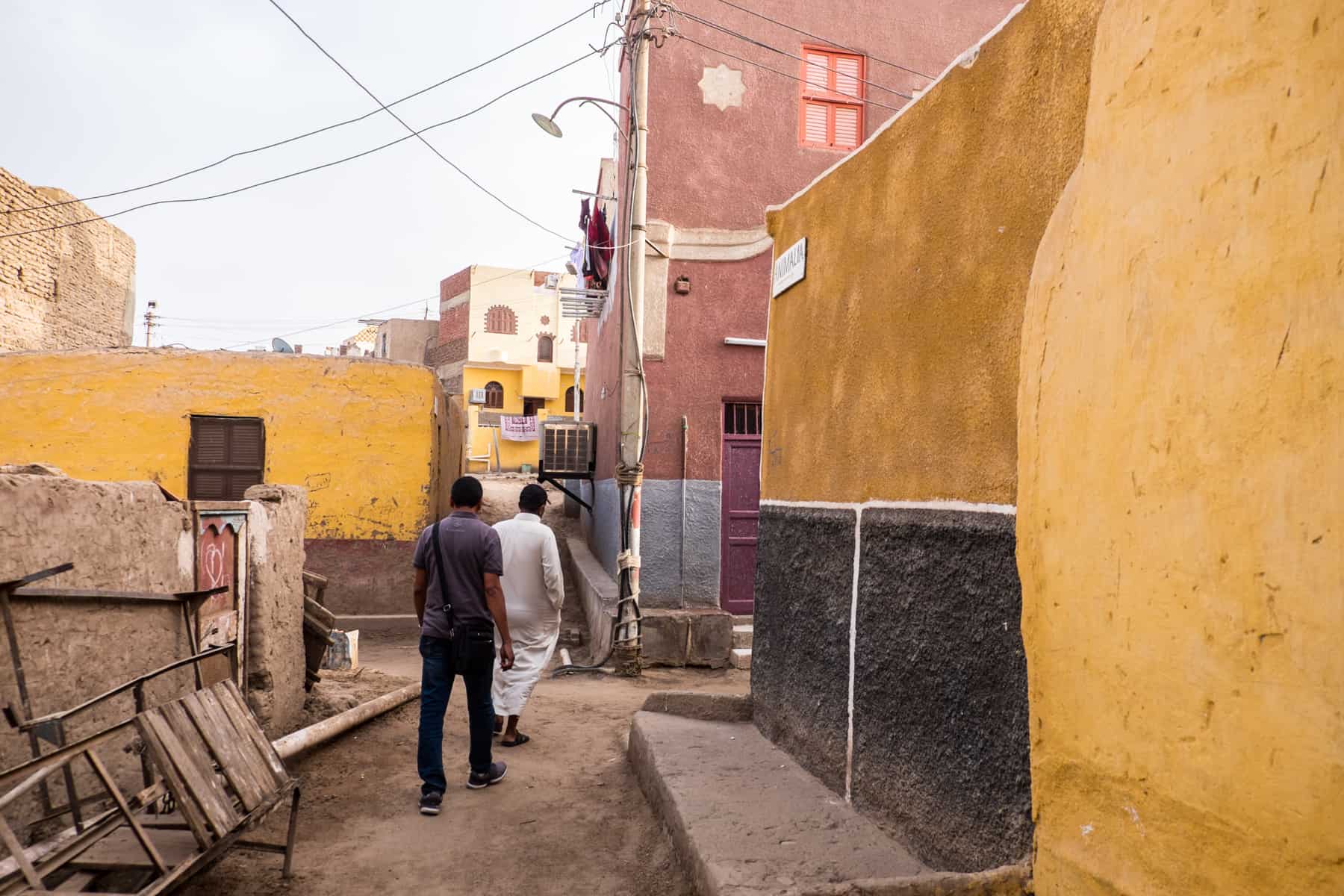
Visiting one of the colourful traditional Nubian villages in Aswan.
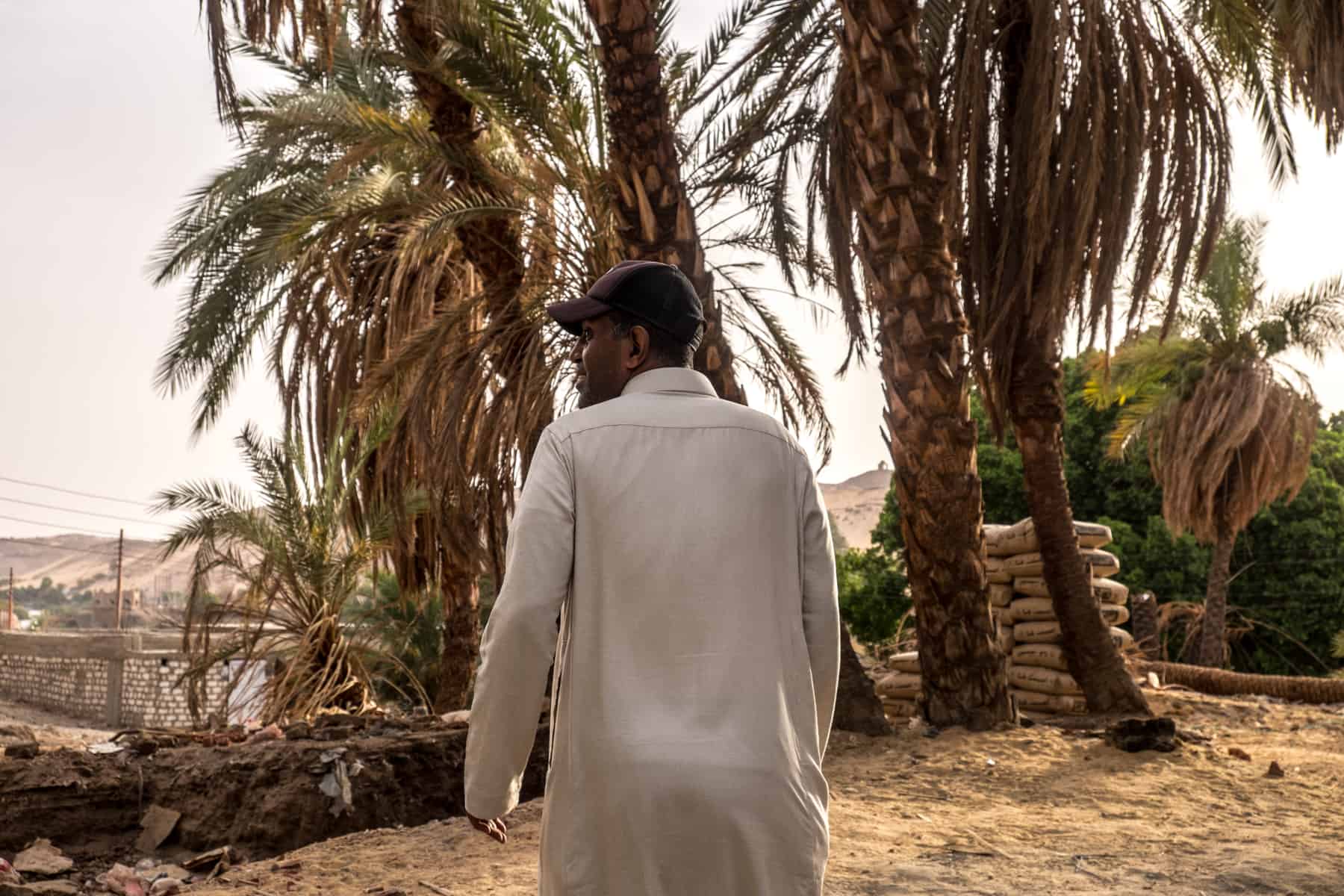
Our Nubian friend proudly showing off his village that sits on the banks of the Nile in Aswan.
The Nubian culture, described as having a distinctively African feel to it, is one of Egypt’s oldest (mainly found in Aswan and Southern Egypt) and considered one of the earliest civilisations found in ancient Africa.
The host family (on a rotation basis using more than one household) can use this ‘local living moment’ on our Wonders of Egypt trip as a regular source of income. At the same time, travellers learn about Nubian people and culture in modern-day Egypt. It’s all a part of travelling for good and making sure your tourism dollars are spent directly in local communities.
Philae Temple
Sailing across another part of the Nile in Aswan brings you to Philae Temple, which once sat on Egypt’s southernmost border. As it is on an island, the only way to reach it is by boat, which adds a little anticipation to the exploration.
This temple is a monument where Greek-Roman history sits alongside Ancient Egyptian. Here, Greco-Roman columns line the exterior entranceways. The last use of Egyptian hieroglyphs adorn the inner walls, and Roman ruins sit side-by-side with temple complexes dedicated to deities Isis, worshipped by the Pharaohs.
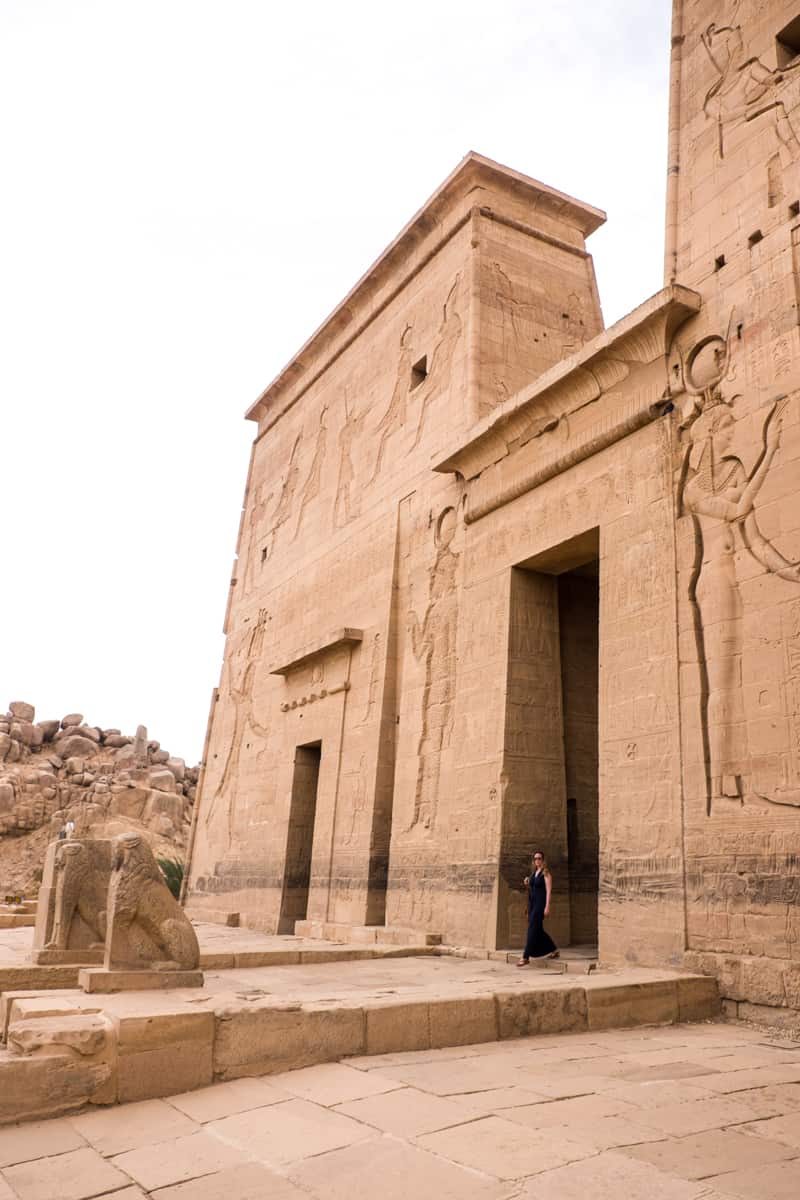
Trying to narrow down where to go in Egypt? Don’t leave the magnificent Philae Temple in Aswan off the list.
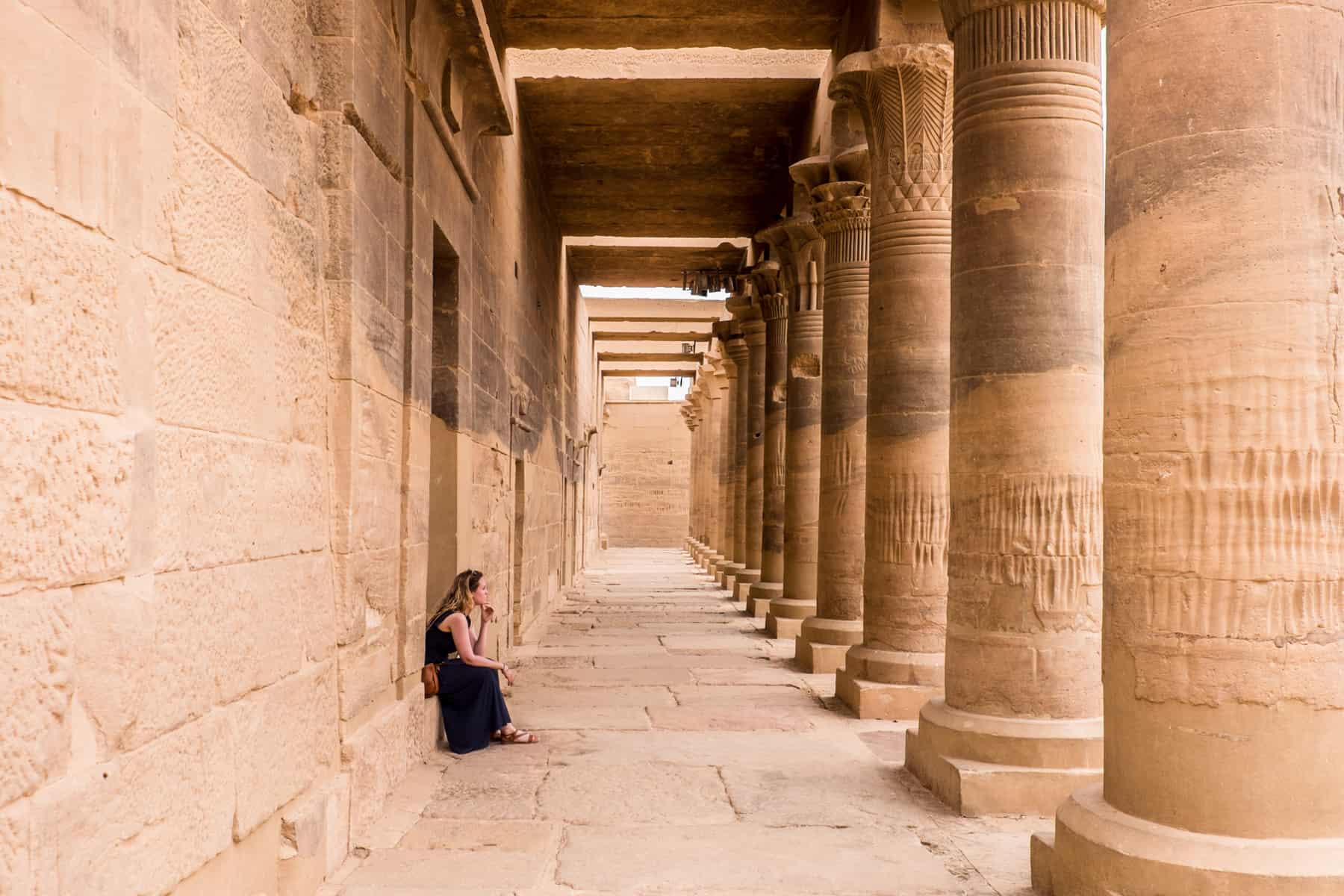
A corridor of columns showcasing greek and roman history at the Philae Temple.
Following the meticulous reconstruction of Philae Temple to ensure its original appearance, the temple is now on nearby Aglika Island as part of a UNESCO protection project. Historians moved the structure from Philae Island after it was at threat of being submerged by the Aswan High Dam’s construction. How mind-blowing is that?
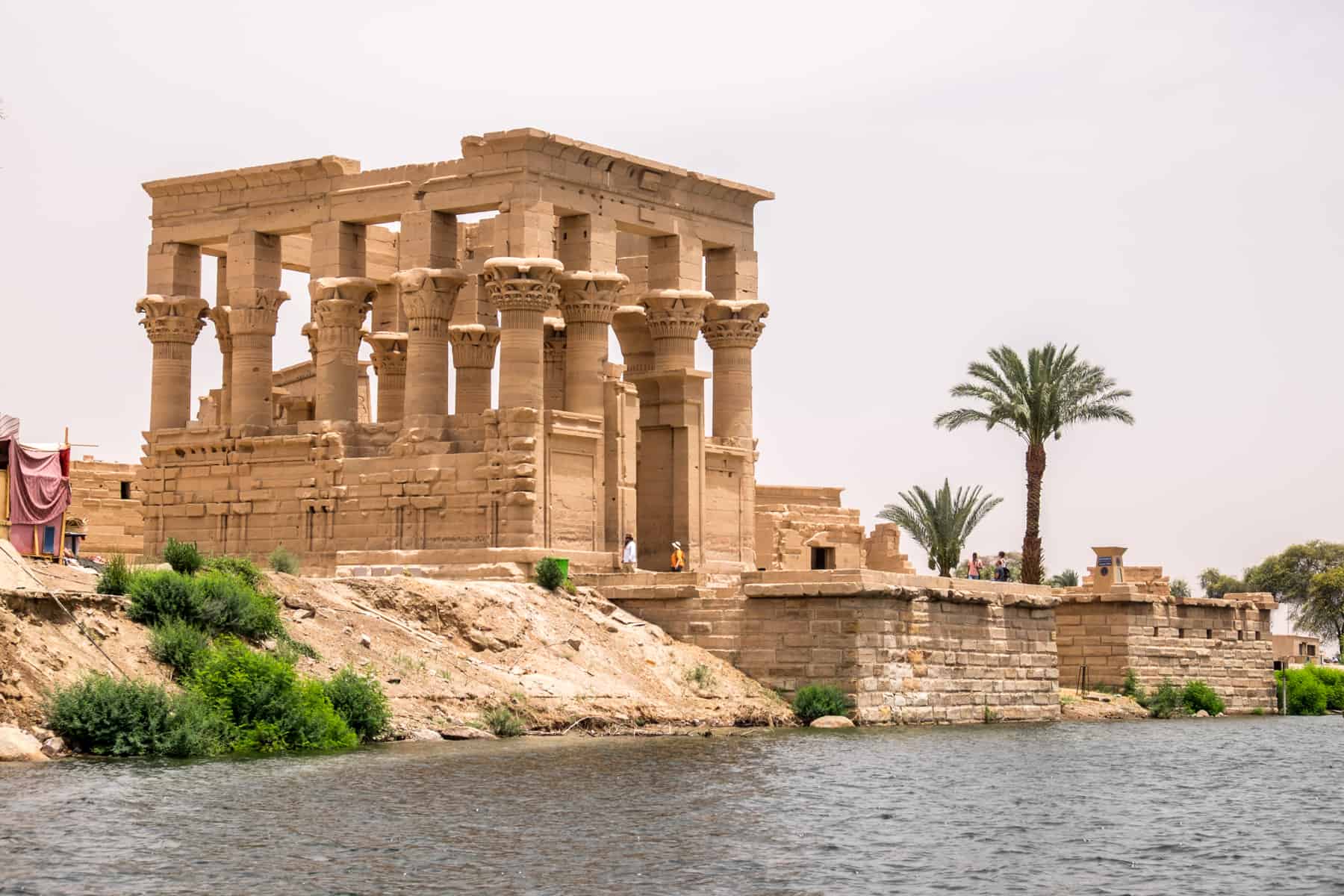
To visit Philae Temple, you must reach the island by boat, allowing for incredible views from the water.
- Opening hours: 07:00 – 16:00
- Philae Temple Ticket Price: 80 EGP
The Unfinished Obelisk
I took an extra excursion to one of the ancient quarries to see the Unfinished Obelisk. Ordered by the female Pharaoh Hatshepsut (1508-1458 BC), it was the tallest Egyptian obelisk ever erected until that crack happened while being carved out of the quarry.
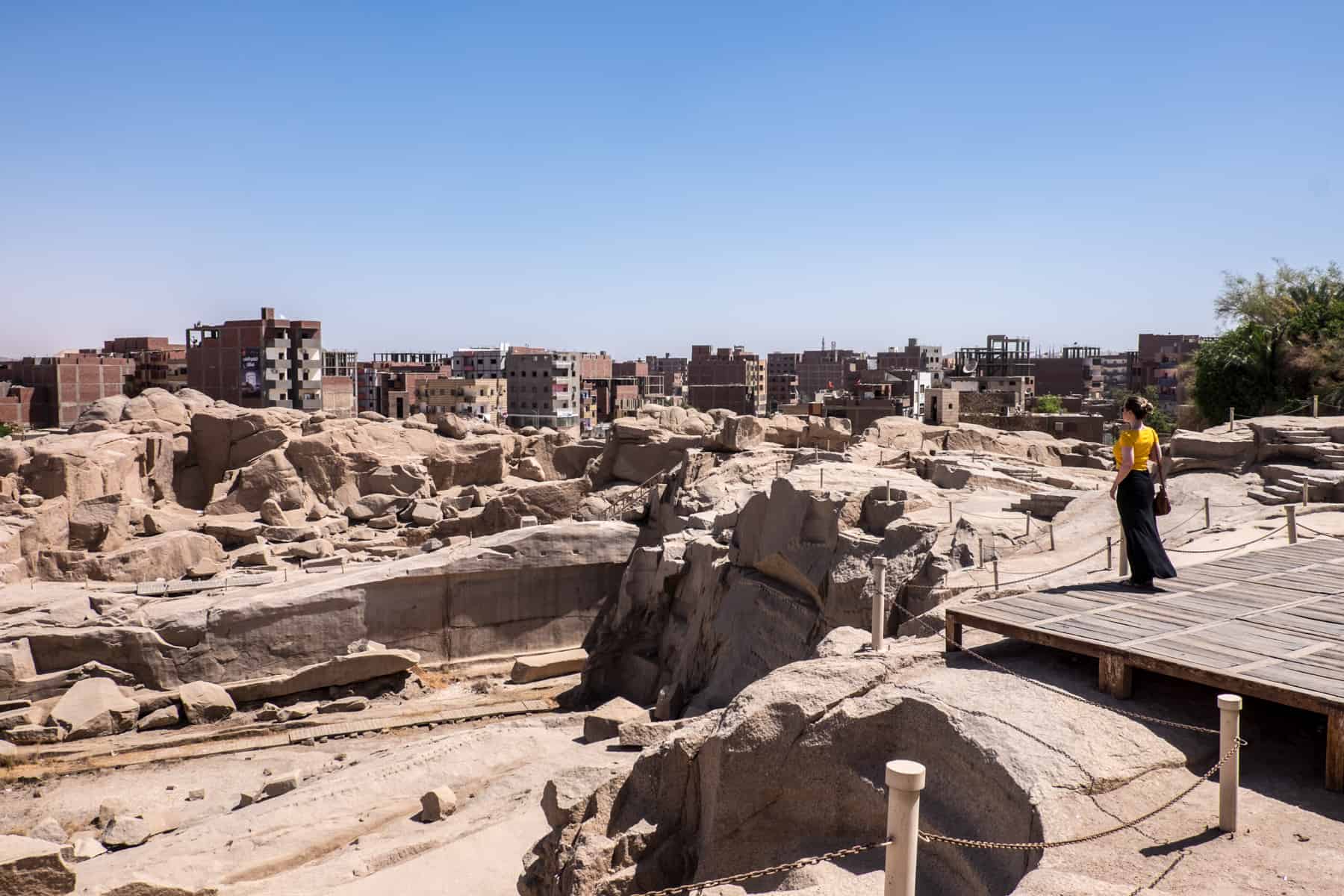
The ancient quarry site in Aswan where you will find the Unfinished Obelisk.
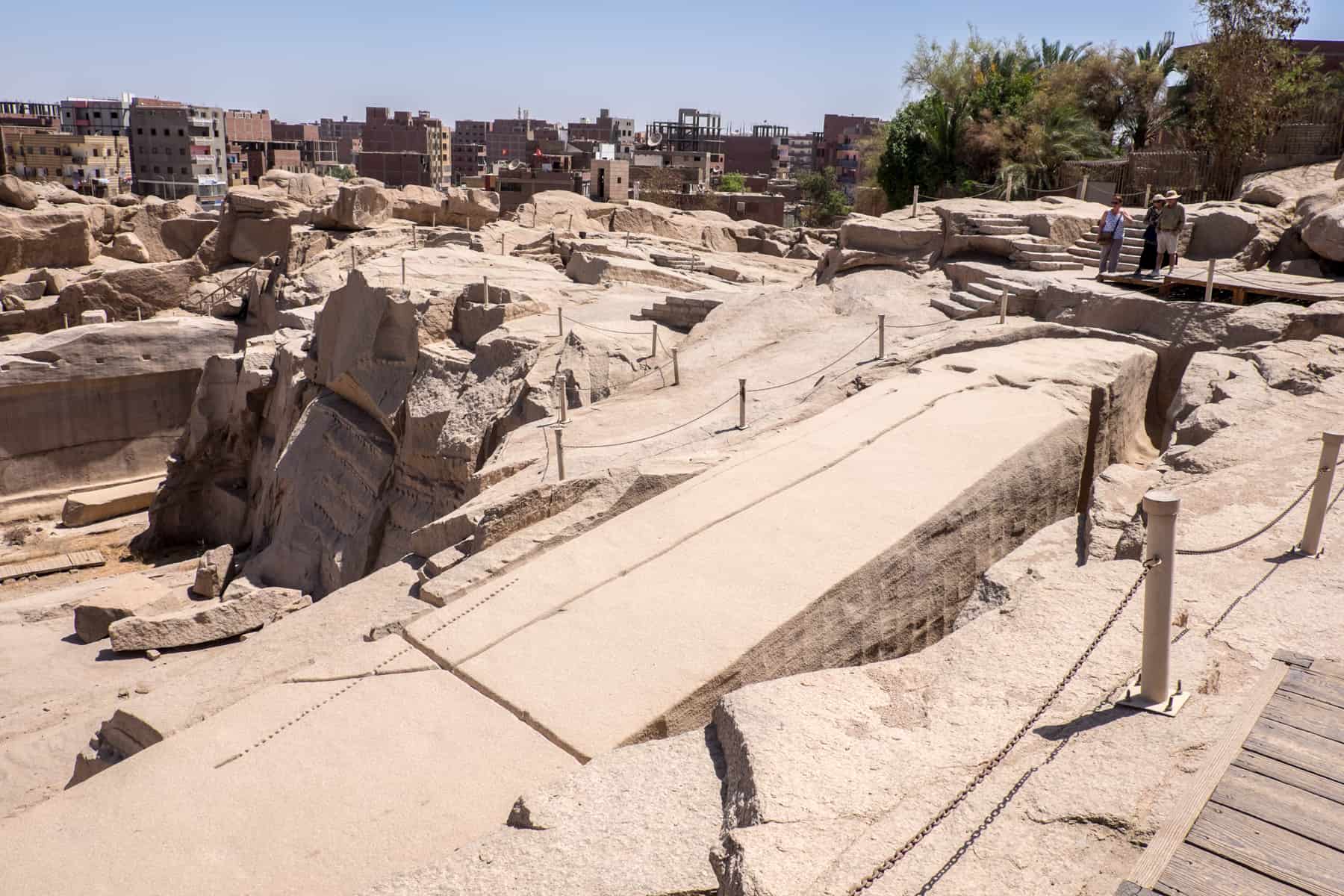
See the enormous crack? It’s how the Unfinished Obelisk in Aswan got its name.
- Opening hours: 07:00 – 16:00
- Unfinished Obelisk Ticket Price: 80 EGP
Aswan Sharia el Souk
The sounds of vendors hawking their wares, the bright colours of textiles and the heady smell of spices – wandering the souk in Aswan is a chance to mingle with the locals, support them and experience this distinct part of Egyptian culture.
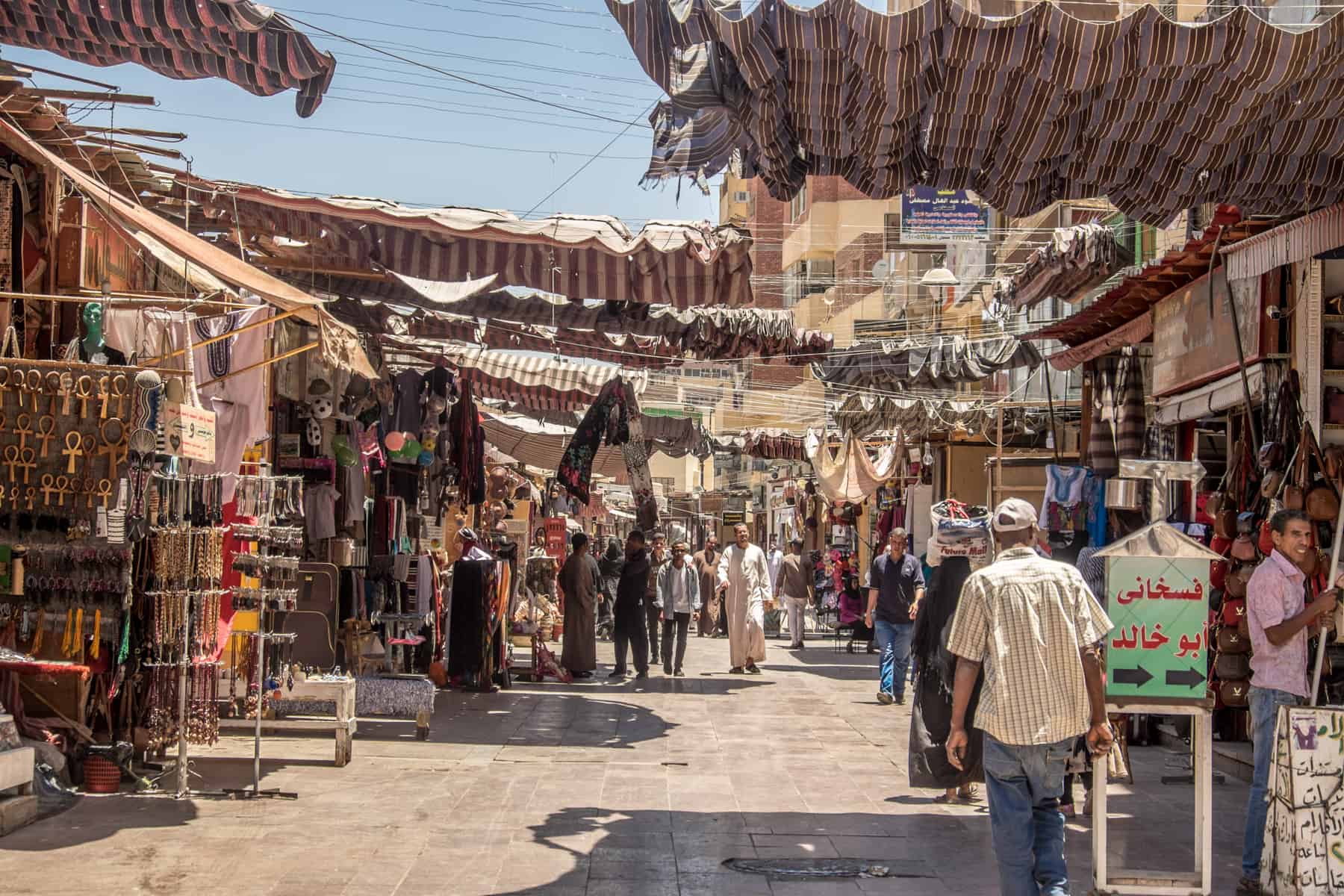
Nothing beats a bustling Egypt shopping experience. Sharia el Souk in Aswan is an excellent way to spend an afternoon.
A Trip to Aswan’s Sharia el Souk Aswan is mostly known for its black pepper, and I was determined to find some to take home for Egyptian inspired dishes. Always shopping local where I can, I met Mr Abed, who owns a super spice shop.
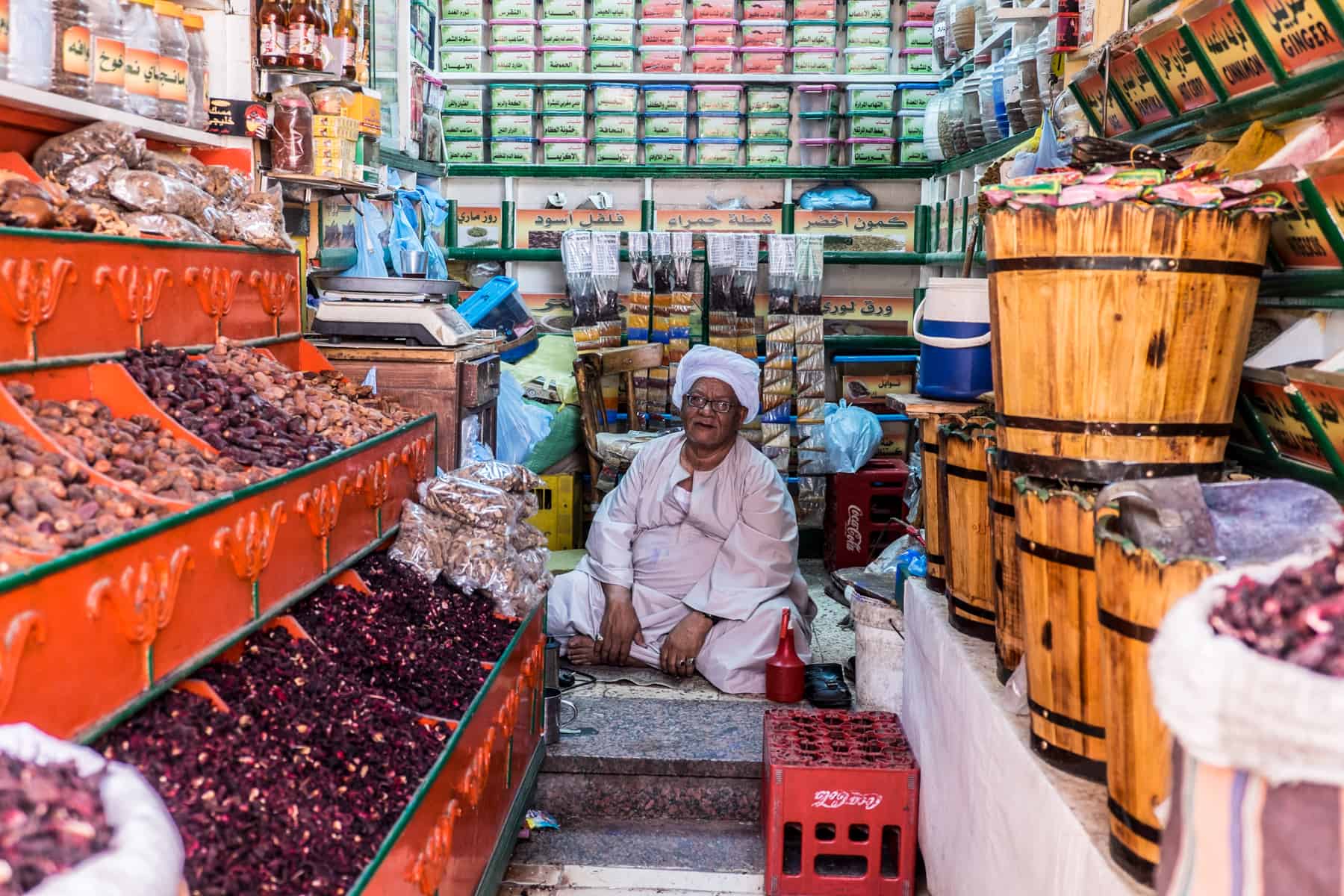
Aswan is famous for its black pepper. Be sure to pay Mr Abed a visit to stock up on your Egyptian spices.
Take a Nile Cruise Between Aswan and Luxor
Aswan is where we also started our Nile Cruise to Luxor—heading upriver on a two-day, three-night adventure, passing the sandy banks, villages, and pockets of an oasis.
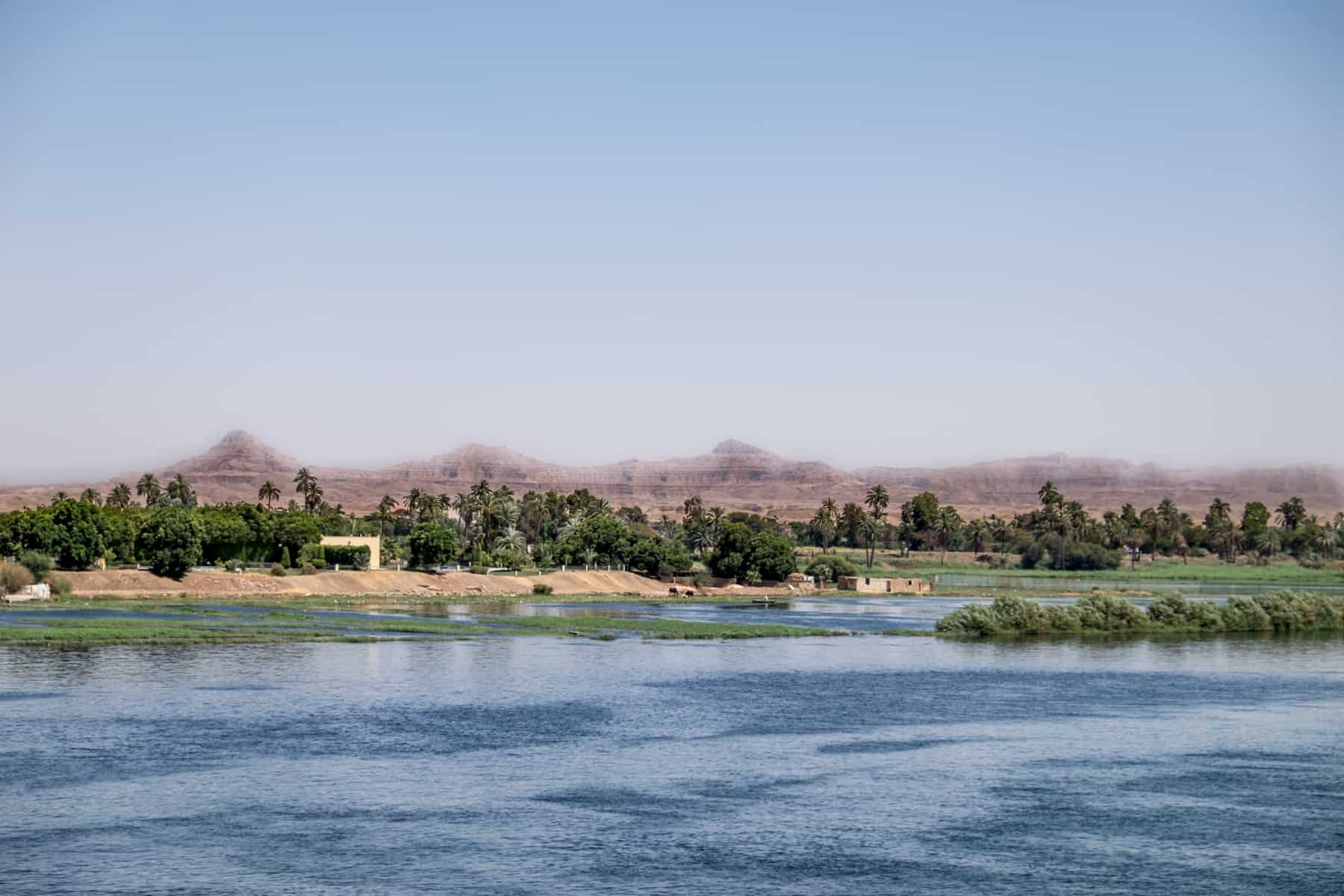
Typical coastline views as seen from a Nile Cruise in Egypt – desert lands, pockets of oasis and mountain backdrops.
Kom Ombo Temple
Viewing a temple in Egypt at sunset is a must. Like how we explored Kom Ombo in its golden glow as one of the excursion stops on our Nile River Cruise.
On the banks of the Nile, Kom Ombo is a ‘double temple’ with two sides and two entrances, built during the Graeco-Roman period (332 BC-AD 395) and dedicated to the crocodile god, Sobek and the falcon god Horus.
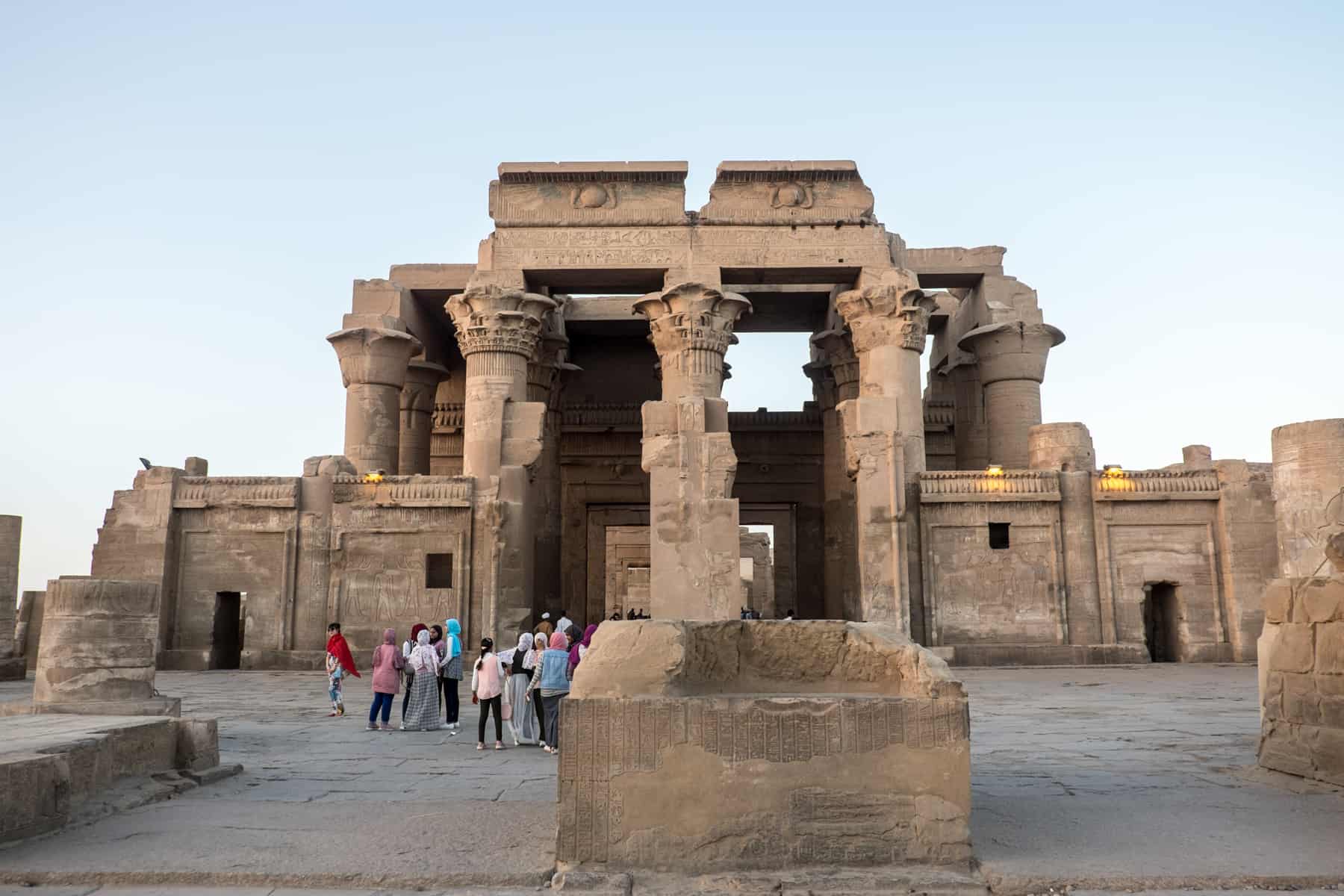
Kom Ombo Temple, as seen as part of a Nile Cruise itinerary.
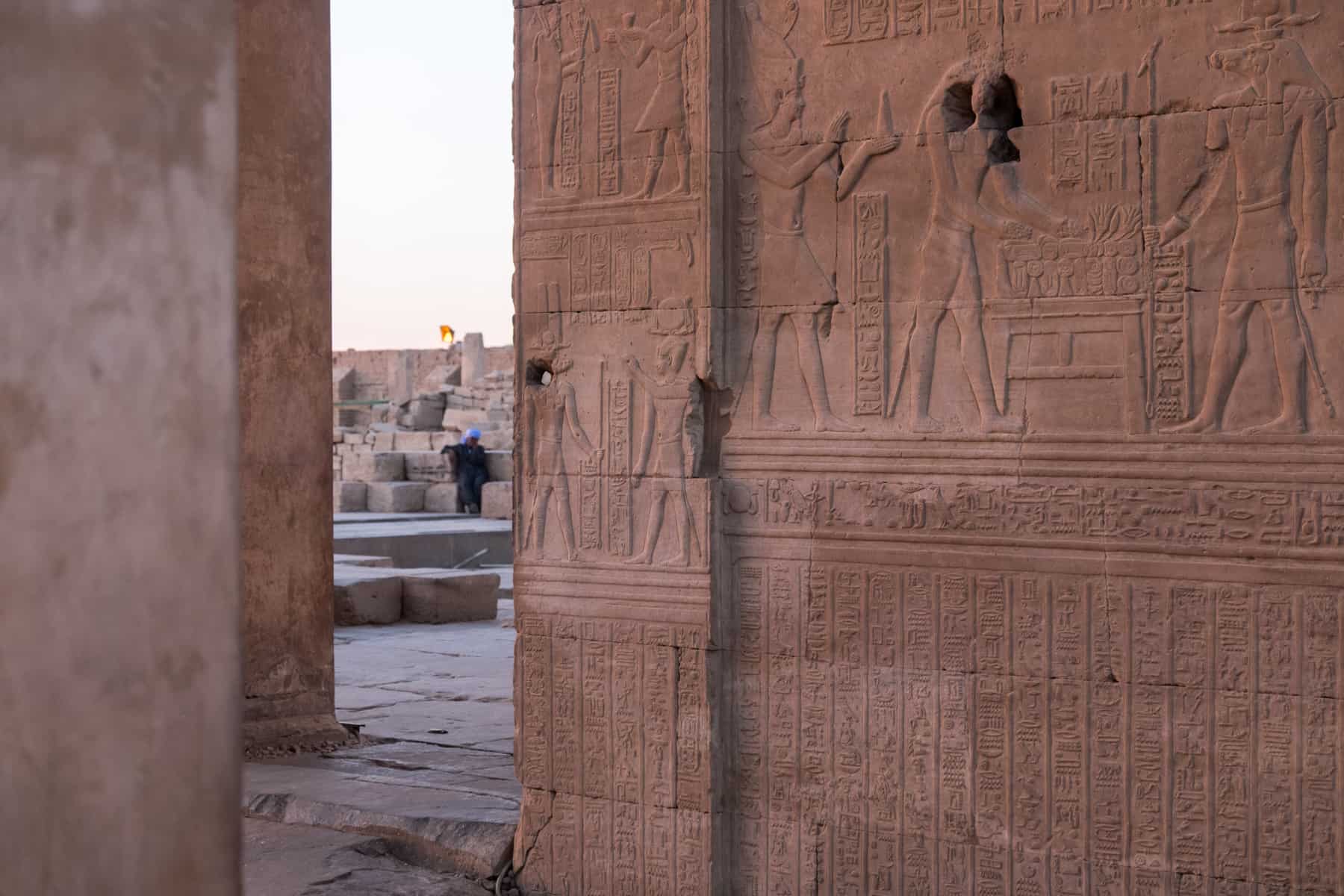
Carved pictures tell stories of Ancient Egypt on the red walls of Kom Ombo Temple in Egypt.
The crocodile, in particular, was important to the people of Ombos. So much so that in excavation, mummified crocs were found in catacombs and are now on display in a dedicated viewing area.
There are some interesting carvings here, including the ancient calendar system and the first representation of medical instruments for surgery that we still use today (such as scalpels, forceps and scissors). One of the guards on-site took us on a treasure hunt to find the tiny carving of an elephant.
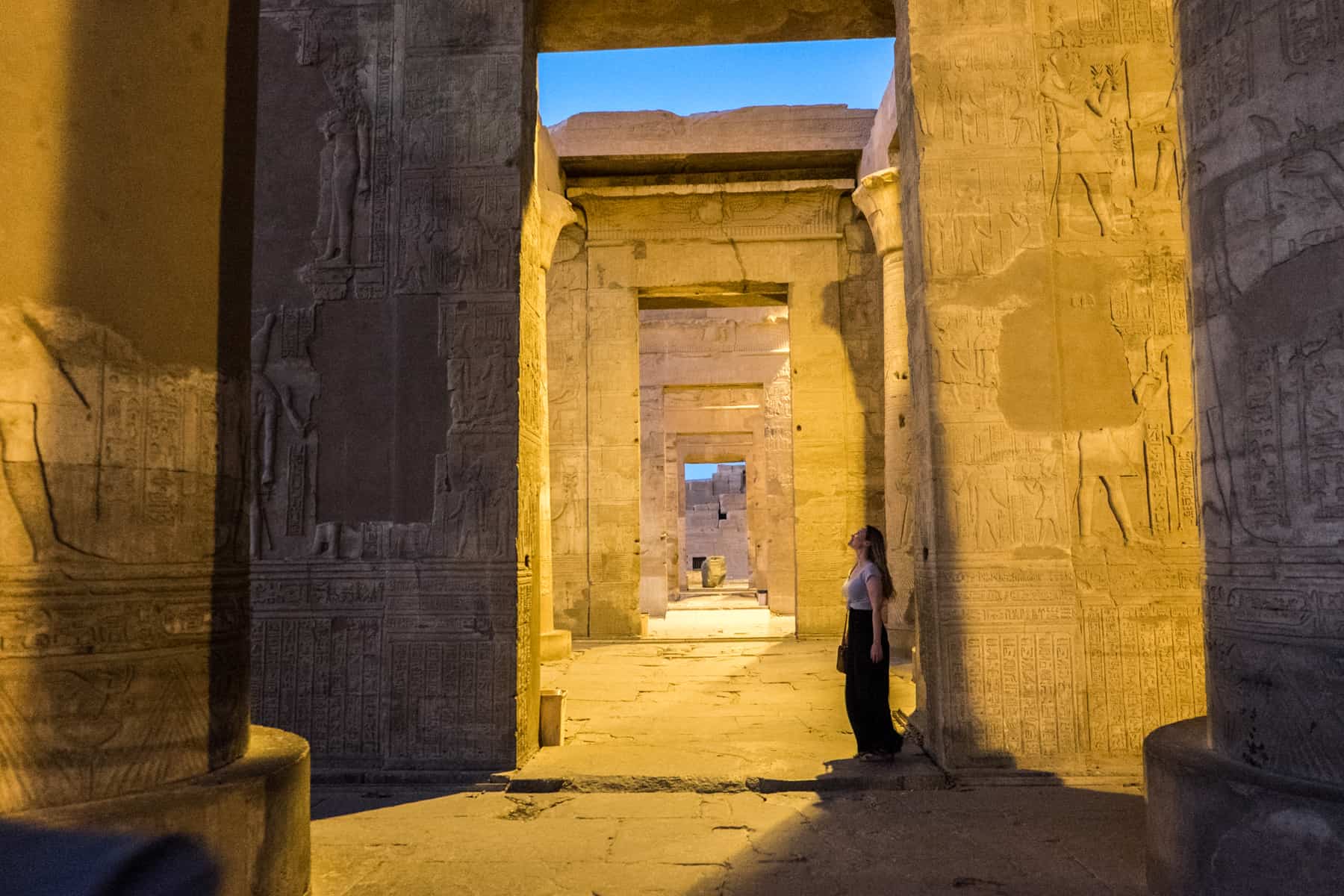
Visit Kom Ombo temple at night and see the carvings in a golden glow.
- Opening hours: 09:00 – 17:00
- Kom Ombo Temple Ticket Price: 100 EGP
Book a Nile Cruise
- Want to cruise Egypt’s famed waters? Book a 2-day Nile River cruise from Aswan to Luxor, which includes a hot air balloon ride.
Luxor – Land of the Greatest Pharaohs
Like Cairo, Luxor is firmly on the tourism agenda as people flock here to get lost within the sandy, stone enclaves of the Valley of the Kings.
Valley of the Kings
No trip to Egypt is complete without visiting the vast archaeological site of the Valley of the Kings for a day.
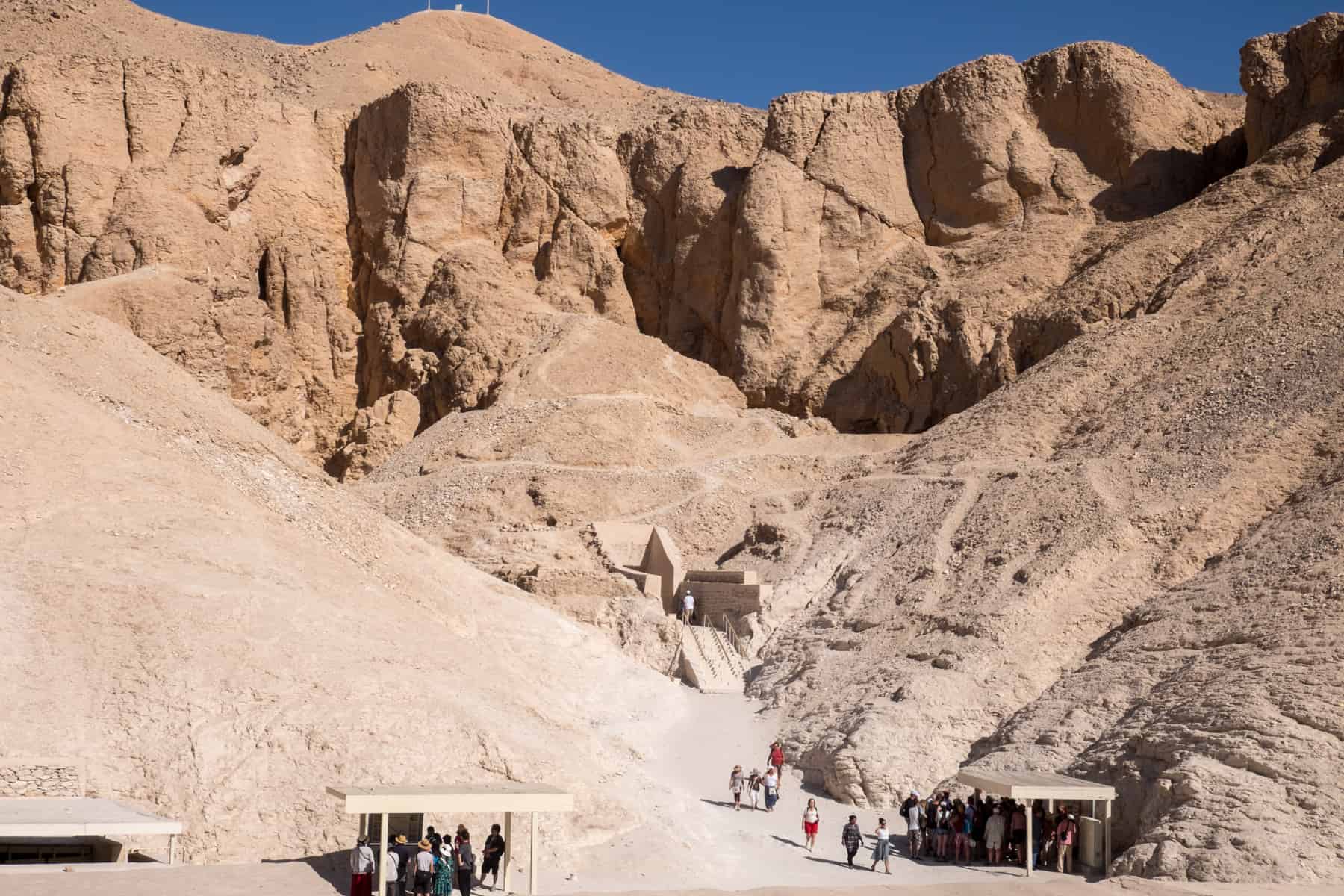
One of the best sites in Egypt in the Valley of the Kings – a network of tombs under the Luxor mountain rocks.
Located on the ancient site of Thebes in Luxor’s West Bank, across the Nile and past vast farming fields, this site is a network of tombs and tunnels – an ancient burial ground and the final resting place for Egypt’s New Kingdom rulers.
It is hard to imagine the intricate network of tunnels and tombs that lay underneath you as you wander this rocky basin, as well as knowing you could even be walking amongst dozens more still buried. In the tombs uncovered, the treasures have been removed (either looted or on show in the Egyptian Museum).
However, each wall painting tells a life story, of triumph and struggle, power and love.
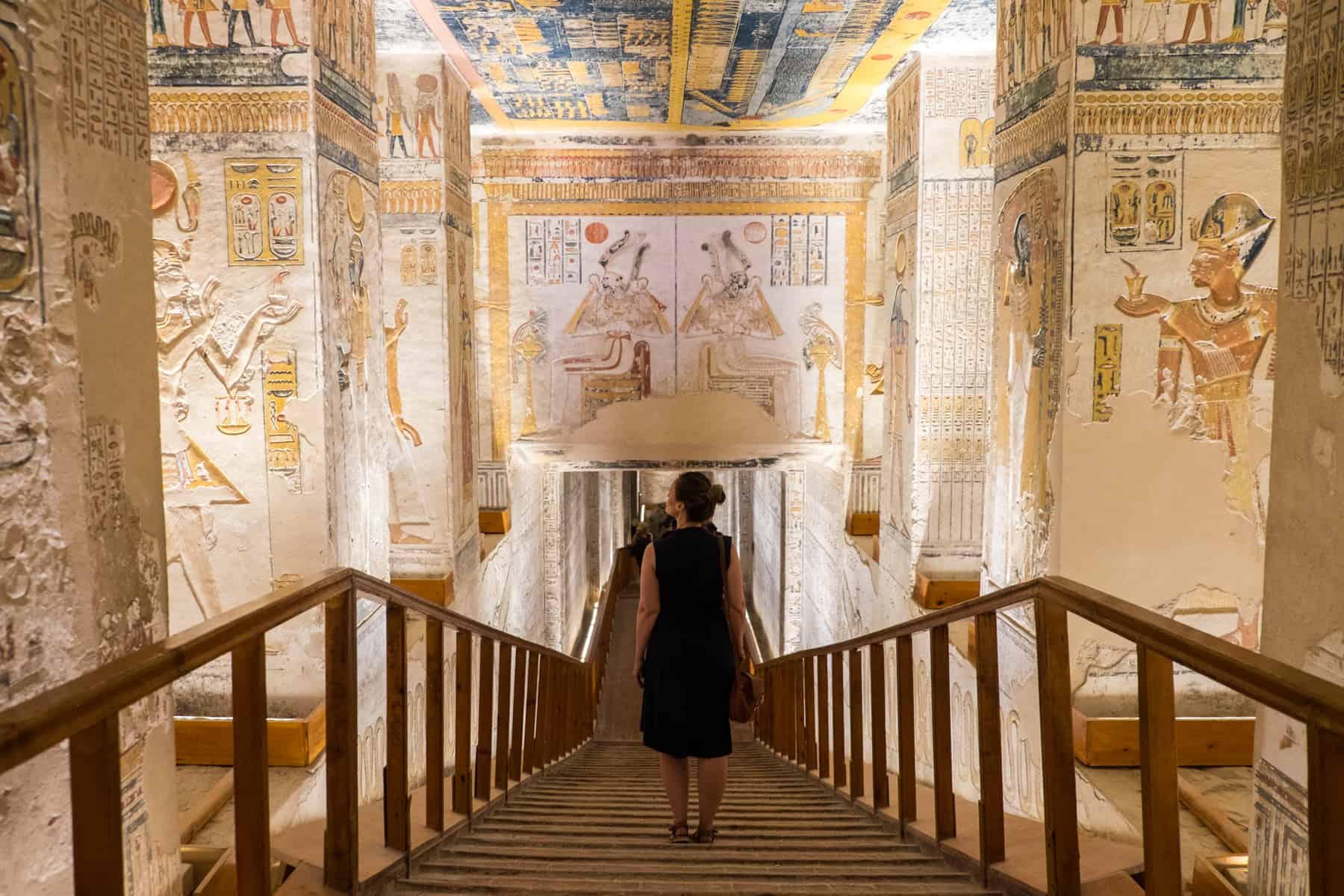
Visiting Ancient Egyptian sites is always a marvel.
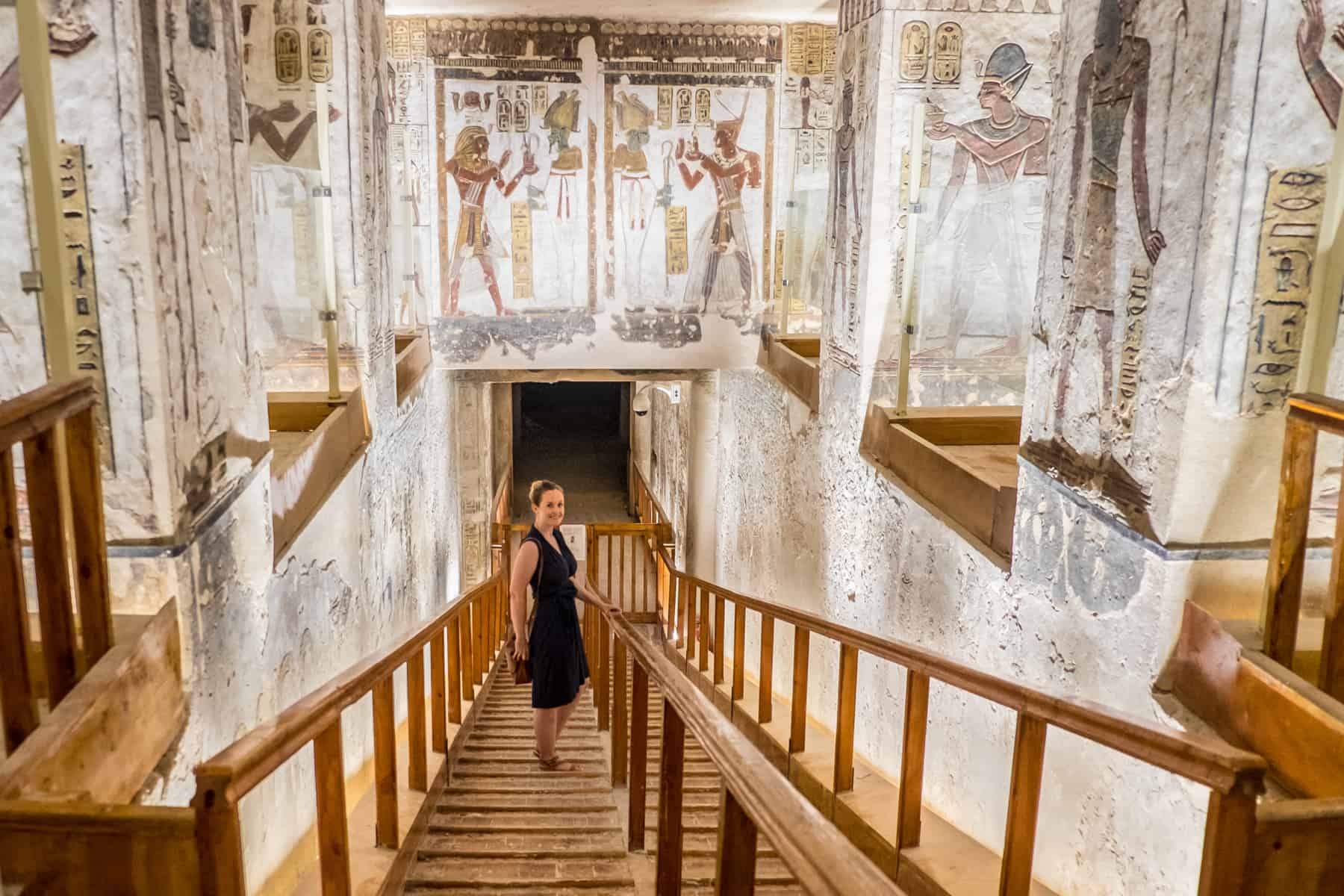
Going deeper underground in tombs at the Valley of the Kings, Egypt.
The ticket for the Valley of the Kings grants you entrance to three tombs out of the 63 on-site and our G Adventures CEO was on hand to tell us the best three to visit that were open that day. The wonders of local knowledge.
The most impressive for me was the tomb of Ramses IV which looks almost like a film set (much of ancient Egypt looks so surreal), and Tutankhamen’s tomb, which is worth the extra ticket cost.
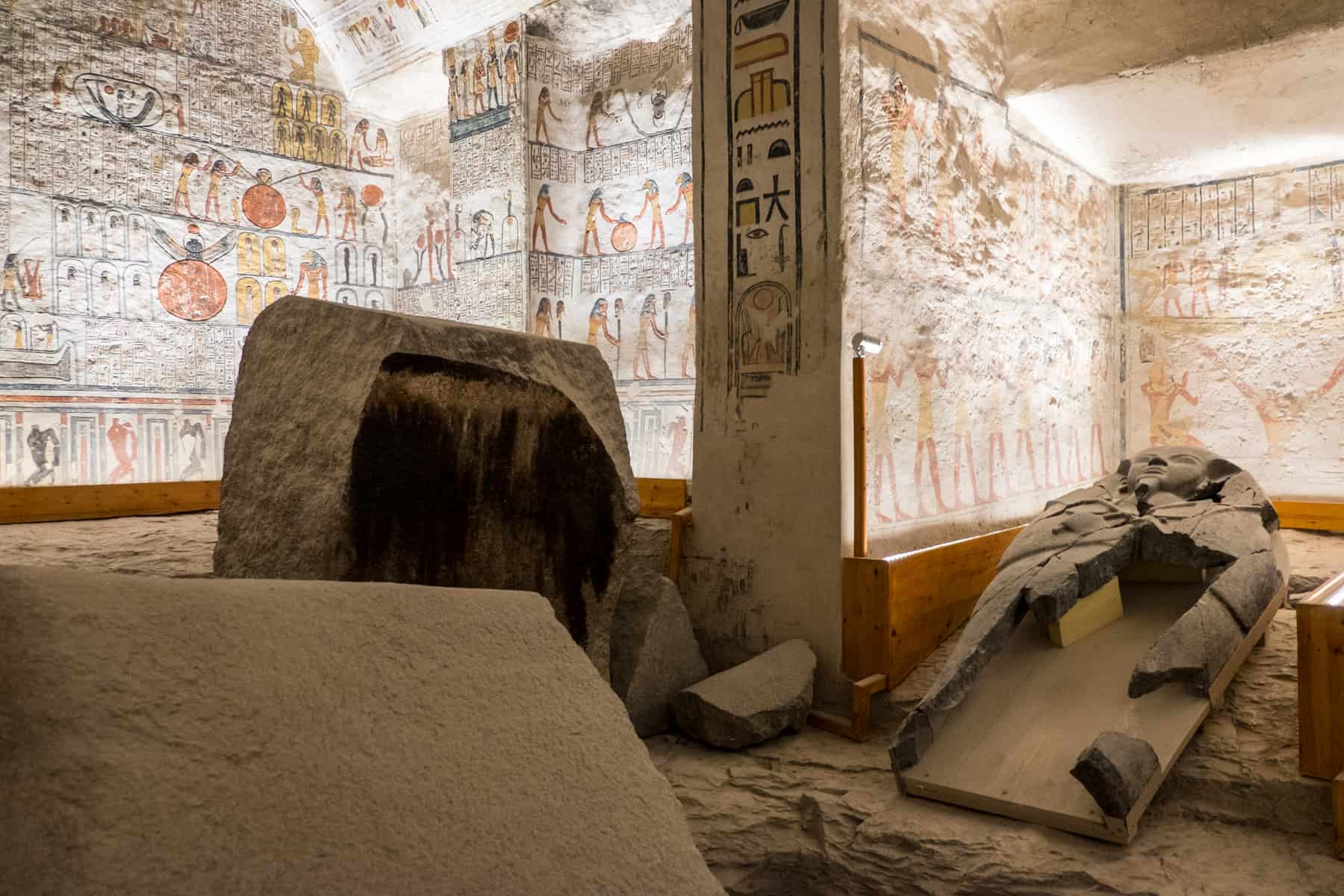
It looks like a film set inside the tomb of Ramesses IV in the Valley of the Kings.
- Opening hours: 09:00 – 17:00
- Valley of the Kings Ticket Prices:
- General Entry (access to three tombs): 160 EGP
- Tomb of Ramses VI: 100 EGP
- Tomb of Tutankhamun: 250 EGP
- Photography Costs: There is an additional 300 EGP fee to take photos in the Valley Of Kings, but it is worth the extra cost to keep these memories.
Tomb of Tutankhamun
Likely the Pharaoh who dominated your school time Egypt history lessons, Tutankhamun is the most famous. Therefore the option to descend into his tomb is a dream come true for most who travel to Egypt and the Valley of the Kings. His treasures may be on show at the Egyptian Museum. Still, his mummified body is the first thing you see when you enter, before taking a few moments to take in the surroundings and realise what a momentous moment it must have been when this space was first found.
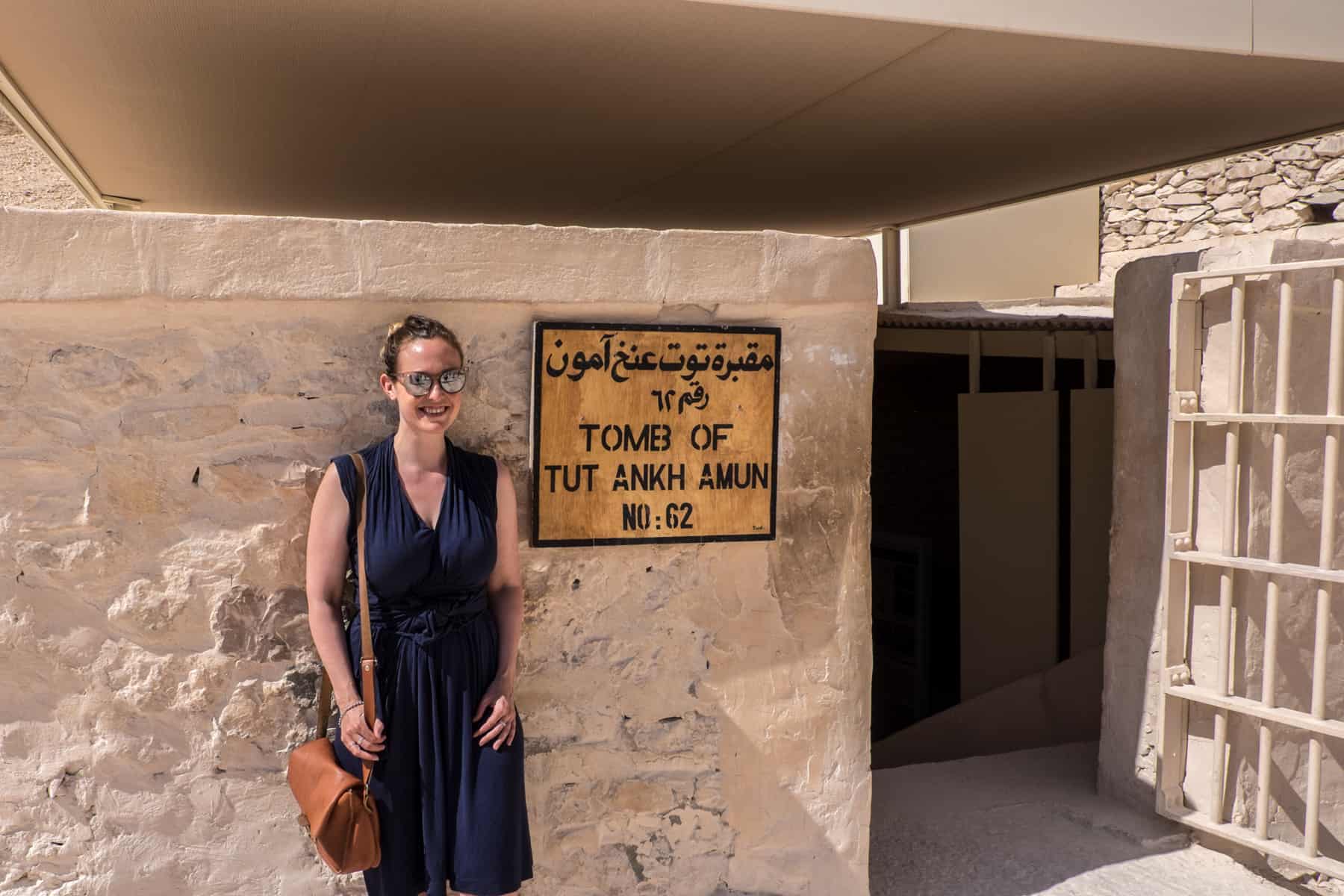
The entrance to the Tomb Tutankhamun in the Valley of the Kings – well worth the extra ticket cost.
Temple of Hatshepsut
The classic architectural style of the Temple of Hatshepsut stands more as a symbol of the power of female rulers to the throne of Egypt and the means they had to hold onto it. This tiered mortuary temple sits majestically like a castle complex in limestone rocks. While much of the carvings and statues have been destroyed (or stolen), the vision of Queen Hatshepsut shows the disguising of herself as a man, which is why you will still see images of the typical Pharaoh figure.
The restoration you see is down to the work of the Polish Academy of Sciences, who painstakingly reconstructed three levels of the temple.
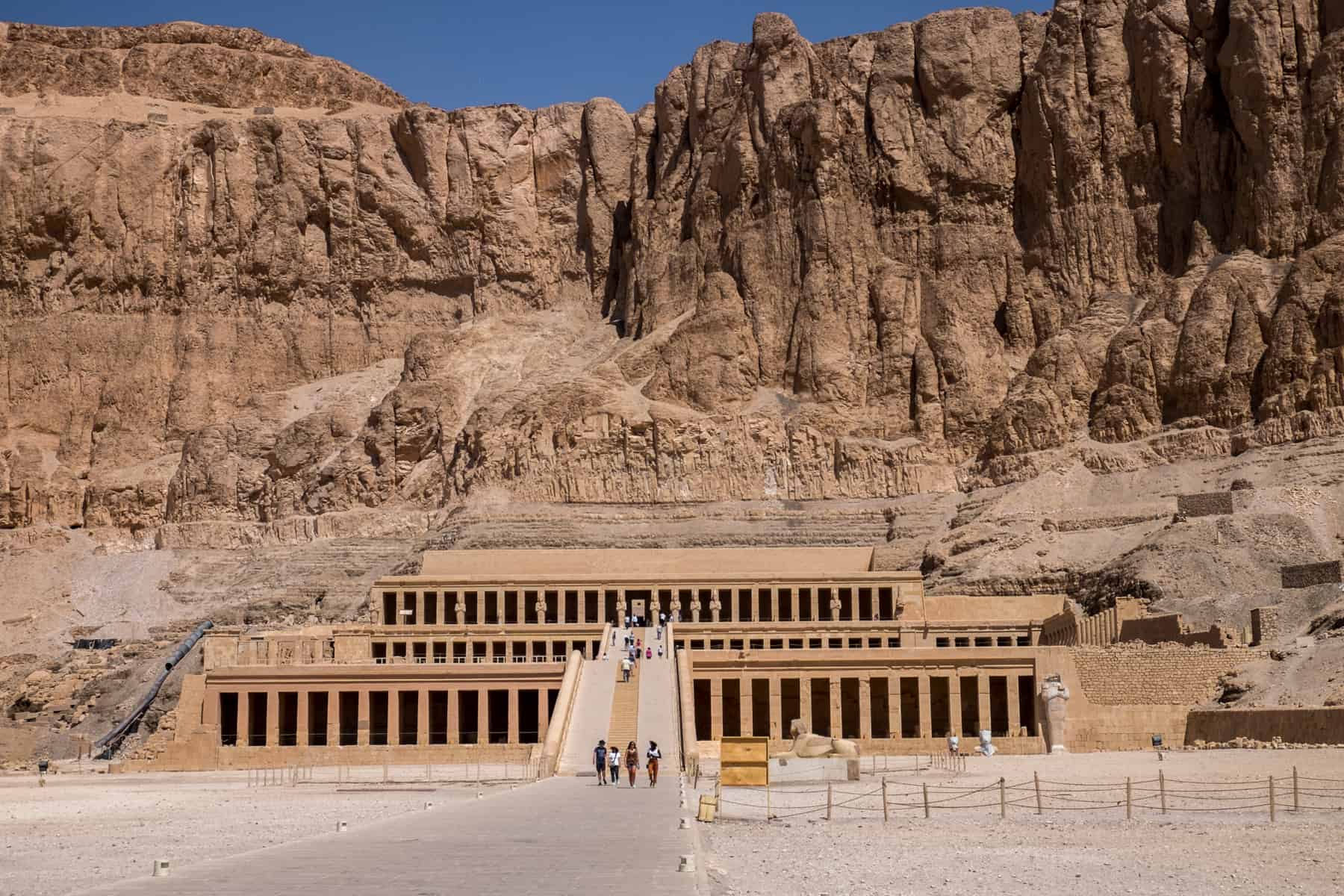
The restored three-tiered Temple of Hatshepsut in Luxor, Egypt.
- Opening hours: 09:00 – 17:00
- Temple of Hatshepsut Ticket Price: 80 EGP
Colossi of Memnon
Behold the two 18-metre high mammoth statues of Amenhotep II at the Colossi of Memnon site. Now protruding from a small, grassy roadside oasis, they once used to stand at the front of a grand temple that no longer exists in the city of Thebes.
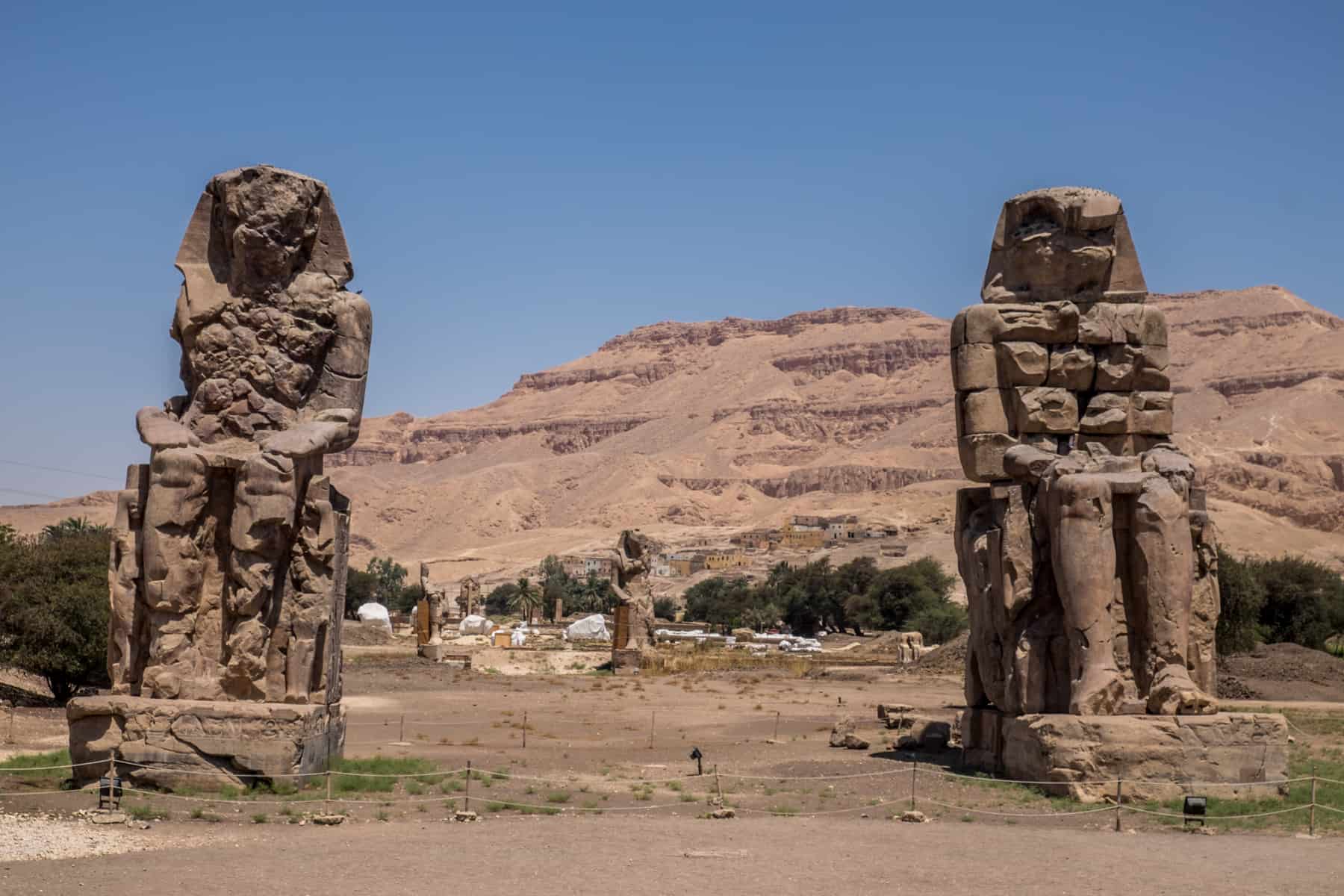
The Colossi of Memnon dominate a patch of land in the Luxor valley.
- Opening hours: 09:00 – 17:00
- Colossi of Memnon Ticket Price: 80 EGP
Karnak Temple and Luxor Temple
Karnak Temple was once the centre of all religious life in Egypt and the largest religious structure ever constructed – built and extended by generations of Pharaohs for over 1,500 years. This house of the gods is Luxor’s grandest temple and is a site so large that it requires a few hours to stroll the columned corridors of the temples and maze-like chapel side rooms. It is split into separate temple sections such as The Temple of Ptah and The Temple of Mut. Most notable is The Great Temple of Amun – the main area marked with the mighty passageway of the Hypostyle Hall, comprised of 134 towering sandstone columns in 16 rows.
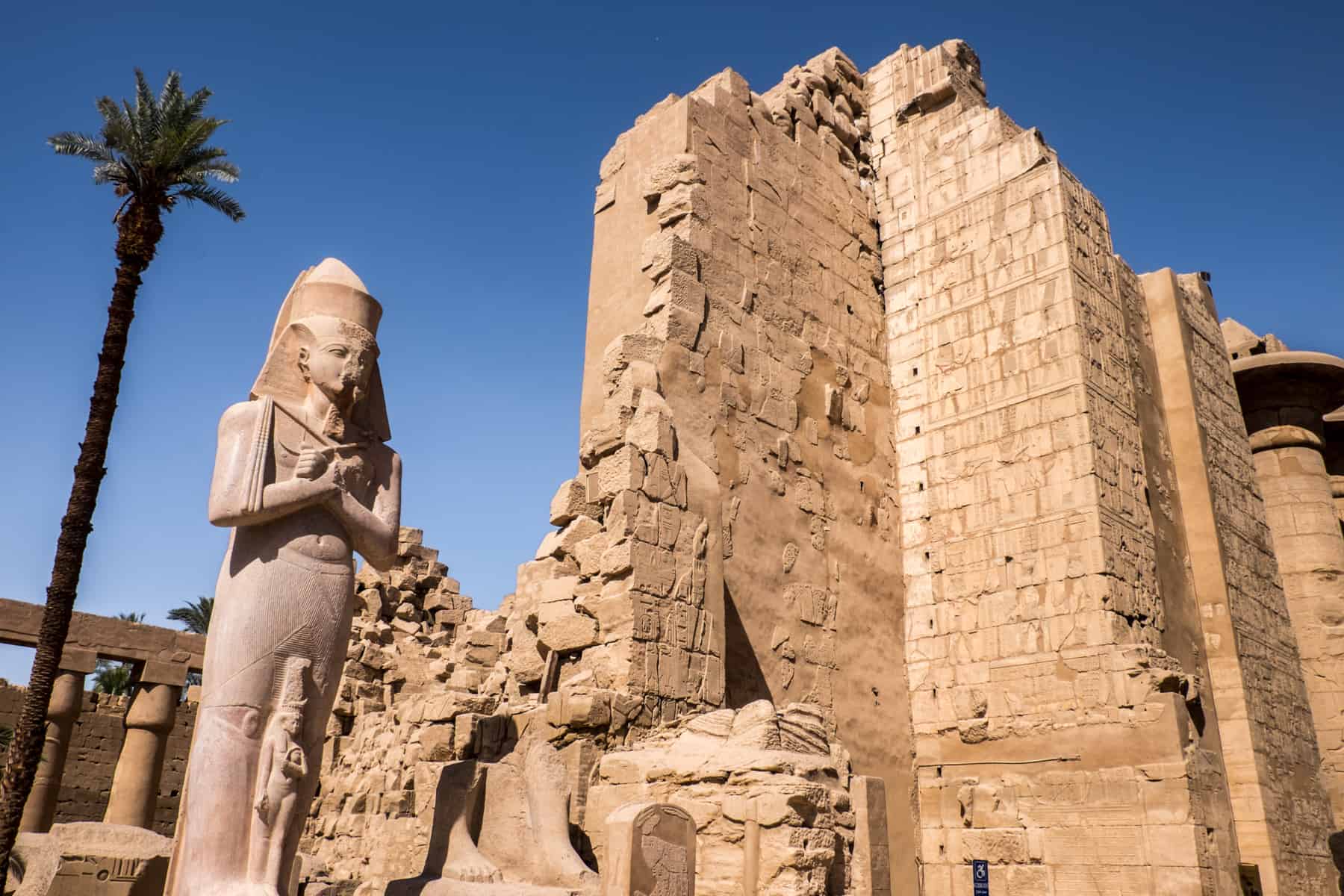
Karnak Temple in Luxor is one of my top three best sites to visit in Egypt. Dedicate a few hours to explore.
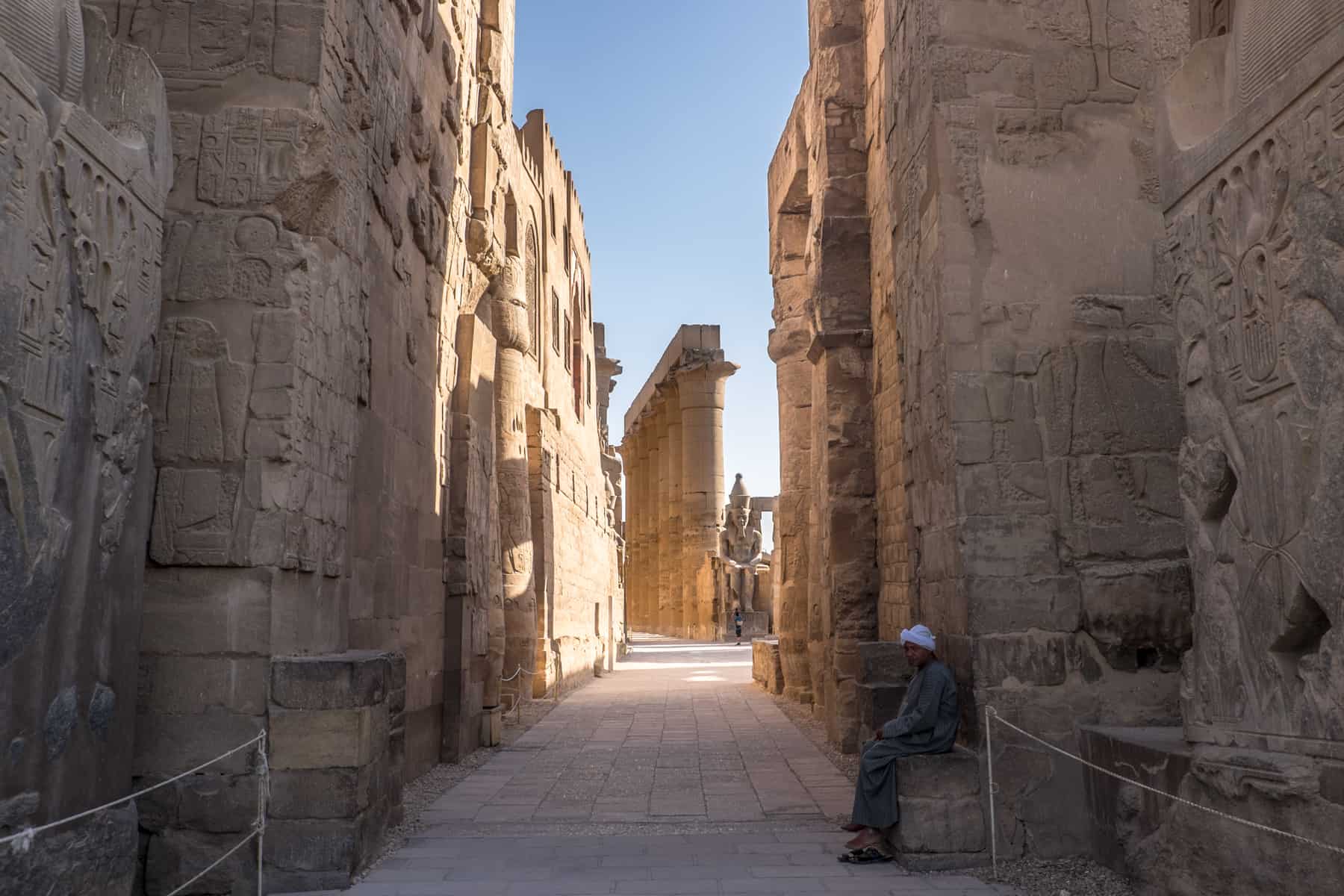
An Egyptian temple guard oversees the ancient history of the Karnak Temple complex.
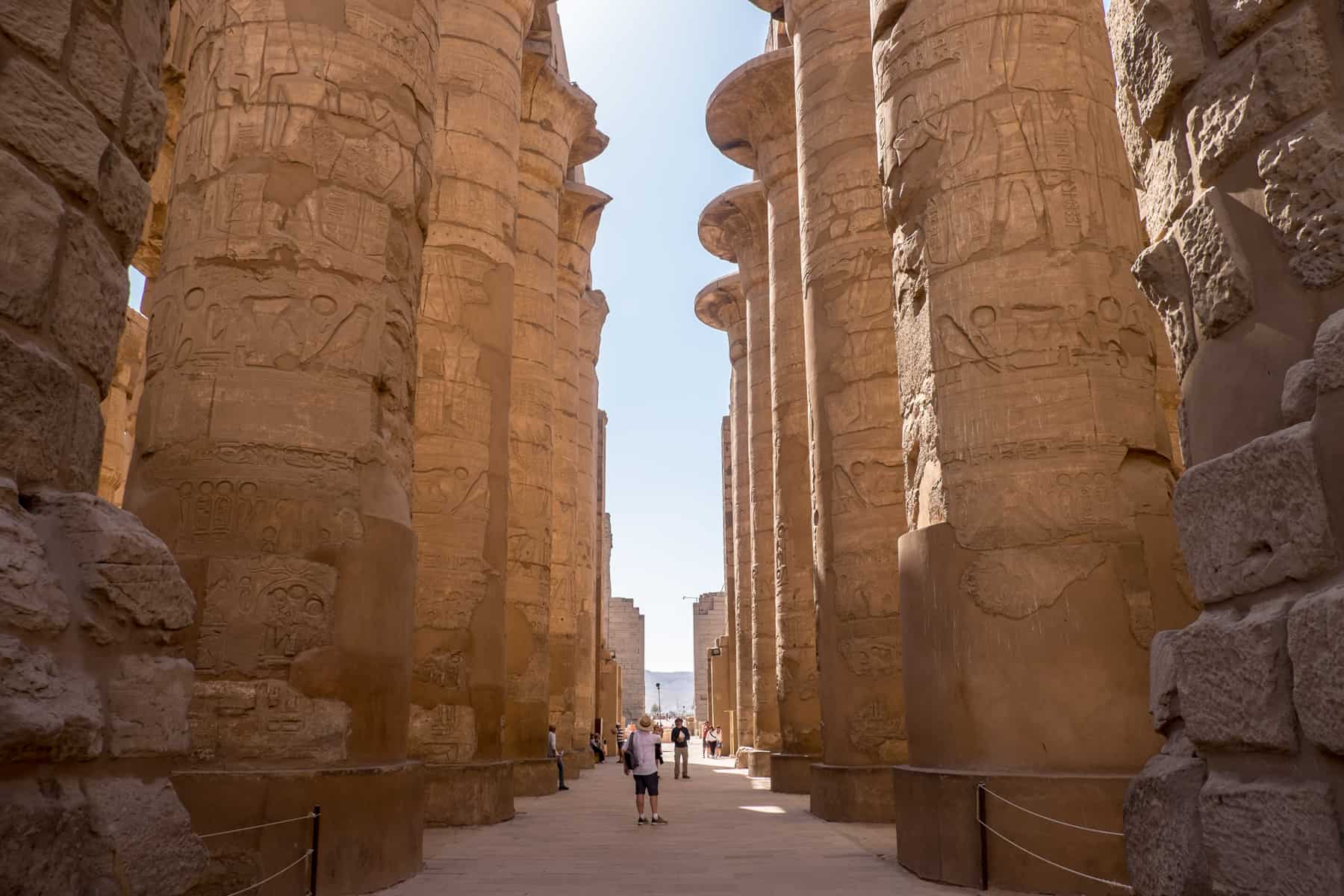
Get lost amongst the 134 sandstone columns in 16 rows at Karnak Temple in Luxor.
Luxor Temple may look small, but like many others in Egypt, it is big on details and design layers. Most notably in that Ancient Egyptian, Coptic Christianity and Islamic architecture intertwined throughout the temple. It shows its evolution to worship over the thousands of years since its construction in 1390BC. Amenhotep II, Tutankhamun and Rameses II built some parts of the temple.
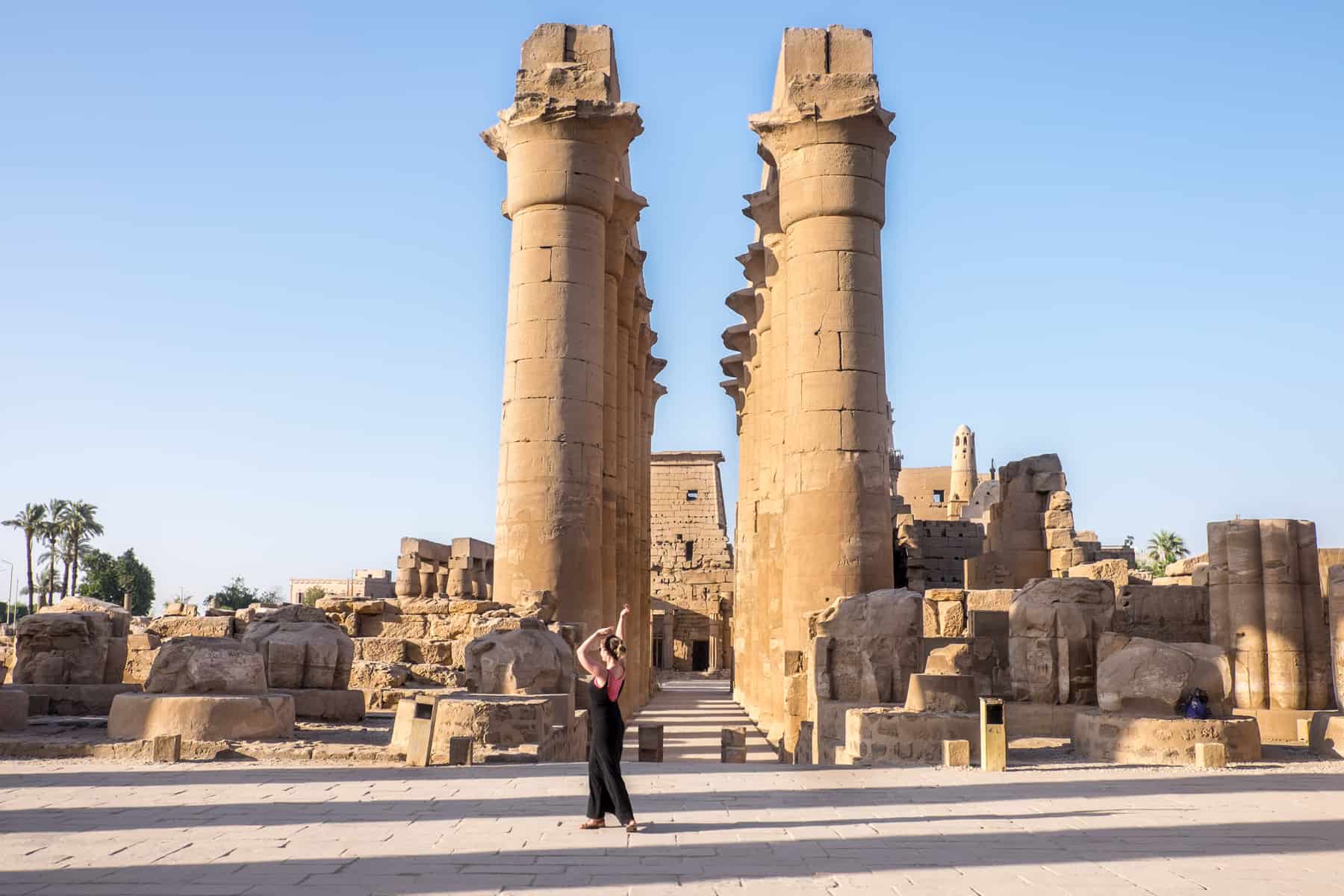
The splendour of the Luxor Temple site in Egypt.
We visited the Temple of Luxor after a morning visit to Karnak Temple to better picture how the recently uncovered two-mile Sphinx Alley connected the two temples. This Alley is currently being uncovered in its entirety – a restoration that will bring back the original pathway to these two sits of worship.
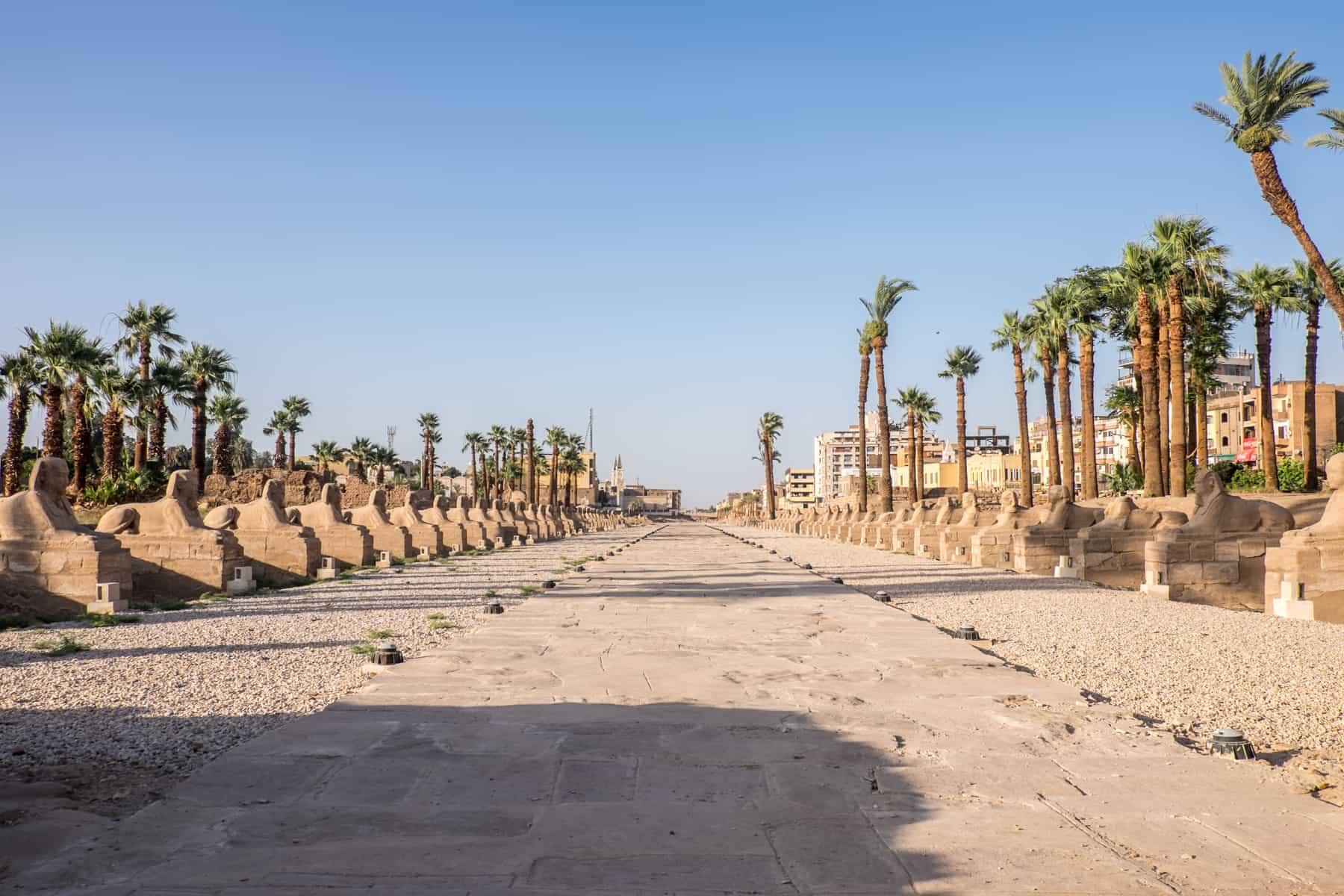
Sphinx Alley – connecting Karnak and Luxor Temples – is currently being fully excavated.
- Karnak Temple Opening hours: 06:00 – 17:30
- Karnak Temple Ticket Price: 150 EGP
- Luxor Temple Opening hours: 06:00 – 22:00
- Luxor Temple Ticket Price: 140 EGP
Luxor Tours
- Choose from full or half-day East and West Bank tours and dig deeper into Egypt’s ancient civilisation.
Egypt Tours to See More
Access the Best Places to Visit in Egypt on a Tour
My tour covered all of the listed sites above, including the Nile Cruise and Abu Simbel excursion, and is a tour designed with a little more comfort in mind. I visited in partnership with G Adventures, detailing travel to destinations responsibly and with purpose. Philae Temple, alongside the Saqqara and Memphis day trip on our return to Cairo, were optional extras but worth the investment for the historical excursions.
There are seven tours altogether, and all include some of the best places to visit in Egypt in different measure, including:
- Egypt on a budget, for those wanting the ease of organisation with minimal costs by using public transport and floating down the Nile on a felucca.
- Shorter trips like Best of Egypt, which covers Cairo, Luxor and Aswan, including sailing the Nile on a traditional felucca and the Luxor to Cairo flight.
- Visiting the Red Sea area on the Highlights of Egypt trip which includes time in coastal Hurghada an overnight train to Aswan and a felucca sail between Aswan and Luxor.
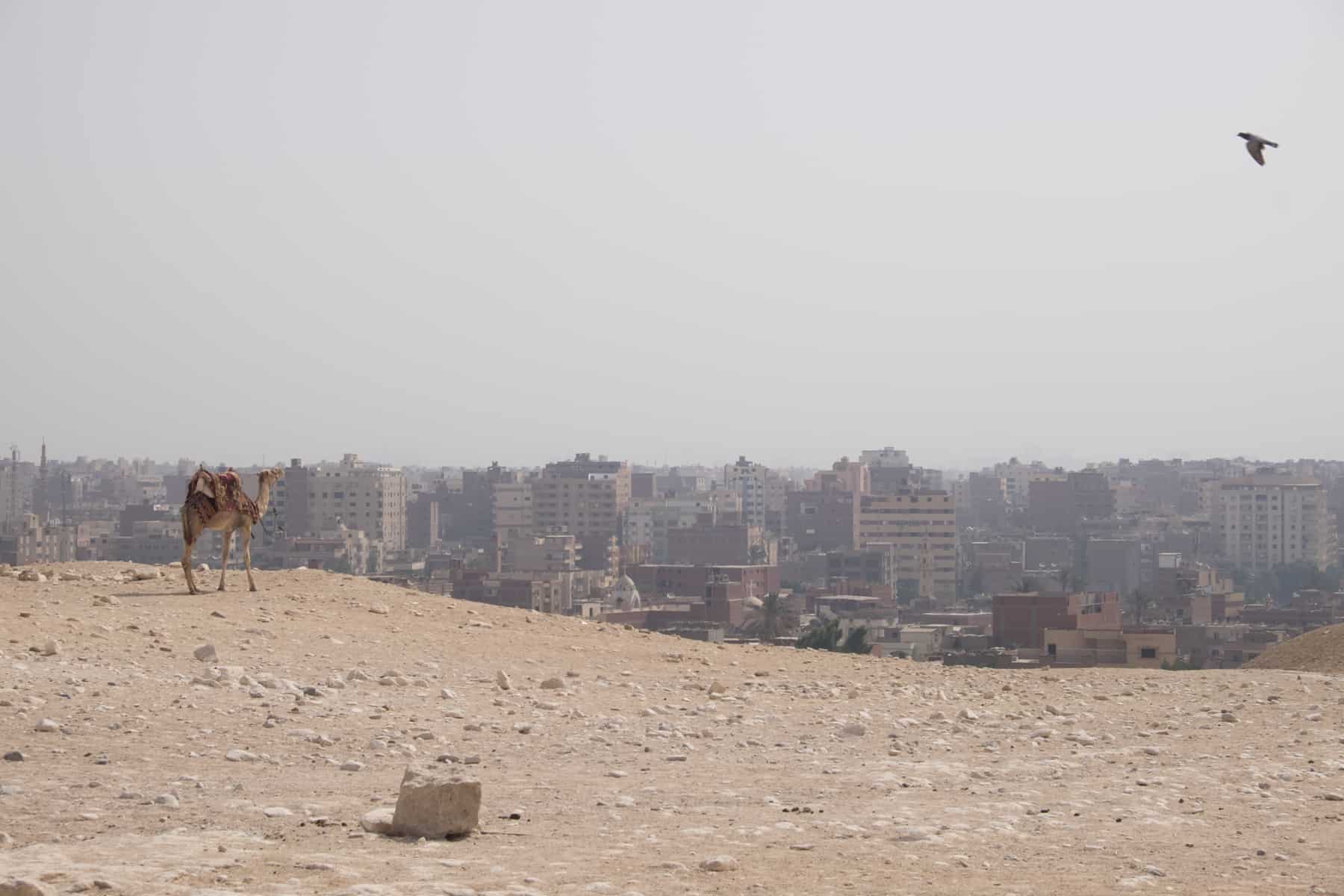
Access more of the country on a tour of Egypt.

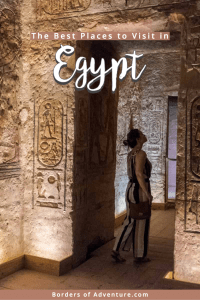
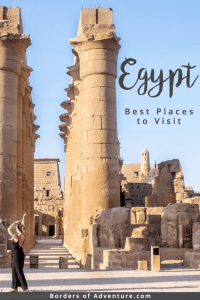

Tom Henty says
It was very interesting reading about Alexandria, as I had to miss the port city in my recent trip. I headed down the Nile to Luxor and Aswan. Thanks for filling in the gaps of what I missed.
Alastair McKenzie says
Spectacularly detailed and useful info here, Becki. That’s a lot of research & editing!
Becki says
You know me too well! Thank you.